In Which Tuor Takes a Littoral Walking Tour, Ulmo Tells All, Gondolin Is Given An Eviction Notice, and Turgon Loves Too Well the Work of His Hands
Chapter 23 of The Silmarillion, “Of Tuor and the Fall of Gondolin,” introduces us to a young man every bit as heroic as fellow mortals Beren One-hand and Túrin Turambar, but he’s given far less page time. Yet Tuor’s role is vital; his descendants will include famous names like Elrond, lore-master of Rivendell, and Elrond’s brother, who also happens to be the founder of Númenor and the ancestor of Aragorn.
The story of the fall of Gondolin is the first of the three great tales that Tolkien dreamed up before the rest of Middle-earth—the other two being the Tale of Tinúviel (Beren and Lúthien) and the Tale of the Children of Húrin (Túrin Turambar, et al.). And geez, given that he was gunning for Gondolin’s downfall so early in his writing career, this secretive Elf-city never really had a chance, did it? More detailed, if not-as-internally-consistent accounts of Tuor’s story can be found in Unfinished Tales (“Of Tuor and his Coming to Gondolin”); The Book of Lost Tales, Part 2 (“The Fall of Gondolin”); and very soon, the stand-alone book that’s likely to contain all of the above, also called The Fall of Gondolin!
For Primer purposes, I’m sticking mostly with The Silmarillion’s more abridged account, sprinkled with a few bits from elsewhere in the aforementioned earlier accounts.
Dramatis personæ of note:
- Tuor – Man (technically a human, but raised by Elves), future mariner
- Ulmo – Vala, Lord of Waters, Middle-earth fanboy
- Voronwë – Half-breed Elf (½ Sinda, ½ Noldo), mariner of Gondolin
- Turgon – Noldo, proud High King
- Idril – Half-breed Elf (½ Noldo, ½ Vanya), clandestine excavator
- Maeglin – Half-breed Elf (½ Noldo, ½ Sinda), goth, turncoat
- Morgoth – Ex-Vala, chiefest and greatest of assholes
Of Tuor and the Fall of Gondolin
First, we have to go back in time a little bit. Just before Morwen sent her son away to be fostered in Doriath, her cousin gave birth to her own son: that was Tuor. But quite unlike Túrin, Tuor gets to know neither his mom, Rían, nor his dad, Huor. Mom left him as an infant with the Grey-elves of Hithlum, then went off and died upon the Hill of Slain, that huge pile-up of corpses thrown together right there on the plains of Anfauglith after the Battle of Unnumbered Tears. Somewhere in that mass grave was also Huor, who died shortly after speaking prophetic words to Turgon, the King of Gondolin, in that same war:
This I say to you, lord, with the eyes of death: though we part here for ever, and I shall not look on your white walls again, from you and from me a new star shall arise.
Well, this chapter connects us to who or what that “new star” is. In the meantime, it might help to bring up the family tree again so we know exactly where he’s come from. So this is what the extended family looks like for baby Tuor:
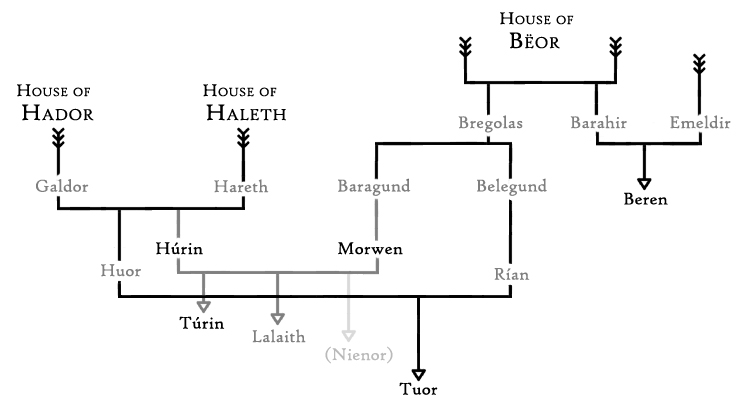
As we can see, Tuor and Túrin are first cousins. Will these two soon-to-be legendary sons of already famous dads of the House of Hador ever meet? Let’s find out.
Young Tuor, like Aragorn, is fostered among Elves after having lost his father to an Orc arrow in the eye! (Although at least Aragorn had his mom around for a good long while.) He has no mortal playmates, nor grown-ups of his own race watching over him—only the Sindar who live in hiding now that Morgoth’s got Beleriand in a stranglehold. This is in rather stark contrast to the early life of his cousin, Túrin, who after living with the people of Hador in freedom went on to live in the safety of Doriath. But then, there are a lot of differences between these cousins, not the least of which is that Tuor (a) is golden-haired, not dark-haired and (b) actually listens to the counsel of others.
We’re told that Ulmo, the Lord of the Waters, the primordial power who’s had Middle-earth’s back more than anyone, has chosen Tuor as his instrument. This is both generous of him but also audacious, since by and large the Valar do not meddle in the affairs of Men, or even in those of the Elves of Middle-earth. Ulmo’s a rebel among his own peers—the good kind of rogue Ainur. We know all about the bad kind.
Anyway, when Tuor reaches his sixteenth year, the Elves decide it’s time to get out of Easterling-occupied Hithlum and make for the small coastal havens founded by Círdan far to the south. (We’re not talking whole Elf-realms or strongholds, just the Sindar equivalent of hidey-holes, like a bunch of little baby Nargothronds, only able to exist at all because they’re tiny, they’re tucked away, and they’re far from Angband.) But before they get very far out the door, Orcs and Easterlings, who’ve been on the watch for these very Elves, attack! The Eldar are scattered, and Tuor is captured.
Buy the Book
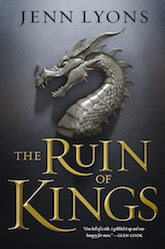

The Ruin of Kings
Then comes the second phase of his youth: thralldom. Tuor becomes a slave to Lorgan, the boss chief of all the Hithlum Easterlings. Suffice it to say this is a rough patch for our hero, but he weathers it. And after three years of servitude, hard labor, and being treated like shit by Lorgan, Tuor escapes! Unfinished Tales adds this fun little nugget:
The Easterlings hunted him with dogs, but without avail; for wellnigh all the hounds of Lorgan were his friends, and if they came up with him they would fawn upon him, and then run homeward at his command.
This immediately reminds me of Beren, who befriended beasts and birds in Dorthonion in his day. Well, Tuor’s mom was of the House of Bëor; this affinity for animals makes sense.
So Tuor returns to the caves where he used to live with the Grey-elves, and he uses it as his base of operations. He’s gone from boy to man and now he’s come into his full strength. So instead of trying again to head southward as the Sindar had intended, he is content to stay and live the outlaw life—the lonely but courageous Beren-like variety, as opposed to the selfish, hard-bitten variety of Neithan the Wronged (aka Túrin). And it’s in this phase of his life, from age nineteen through twenty-three, that Tuor enacts “such great hurt to the Easterlings that Lorgan set a price upon his head.” (Ah, now he’s got this in common with Luke of the House of Skywalker and Han of the House of Solo. Tuor is in good company.)
Tuor is valiant, but not ambitious (at least not when left to his own devices). In some ways, it’s this humility and down-to-earth heroism that sets him apart from both Beren (who hunted Orcs within sight of Thangorodrim and later entered Angband like some sort of Silmaril repo man) and Túrin (who arrogantly tried to take on Morgoth’s armies with brute force and sheer force of will). But Tuor is more obedient than those two, and a trace less vengeful, yet he’s still wise and makes good choices. He’s a loner like Ulmo himself, and he’s okay with it. And that’s why, I think, the Lord of Waters chooses him. Or rather, accounted for him.
Now we need to talk about Ulmo directly because, to paraphrase Corey Olsen, the Tolkien Professor, his fingerprints are all over this story. Going way back to the Ainulindalë, we were told that “of all most deeply was he instructed by Ilúvatar in music,” so he seems to be the most sensitive to the big picture. With his dominion being water, we’re then told in the Valaquenta…
And it is said by the Eldar that in water there lives yet the echo of the Music of the Ainur more than in any substance else that is in this Earth;
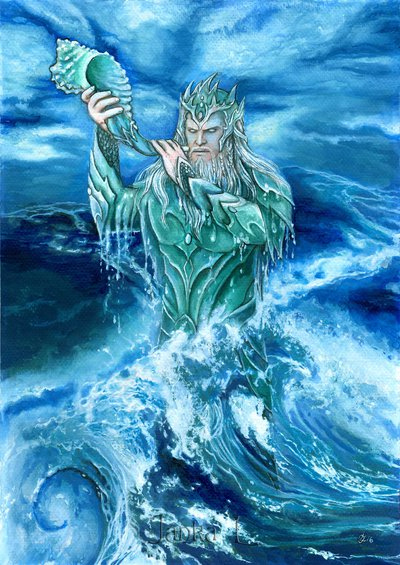
So Ulmo has a unique link to the Music through water, if not quite the the Manwë–Ilúvatar hotline the King of Arda seems to enjoy. He’s a strange sort of Vala, as he lives alone in the deep waters and only hangs with his co-workers when there are big matters to discuss. Yet he’s a chatterbox when you do meet him, and he just can’t get his fill of Middle-earth (and its rivers—don’t forget he’s got favorites!). Remember, he’s the guy who ferried the Nolder and Vanyar over to Valinor at the request of his peers (against his better judgement), then hung with the Teleri at the coasts of Middle-earth before bringing them over later. Yet later still, when the other Valar were all “we’d better not get involved with mortals,” he was the one who still tried to make contact with Men. Not face-to-face, but with messages sent “by stream and flood,” which didn’t really work. Their hearts were moved, but they weren’t configured to understand any of them.
Anyway, let’s get back to our hero. Tuor would probably have kept on leading the Robin Hood lifestyle indefinitely had Ulmo not actively stirred his heart to vamoose. The Vala straight-up places within Tuor the desire to…go west, young man! Tuor doesn’t know why he has this desire, at least not yet. I mean, it’s not like anyone’s ever come around with tracts to teach him about Ulmo. The Valar are just myths to Men, even the Elf-friends (aka the Edain). And it’s not like the Sindar who fostered him have any firsthand knowledge of the Lords of the West; they were never in Valinor, and it’s unlikely any of them were among the Eldar who met and first followed Oromë thousands of years ago.
Still, Tuor follows his Ulmo-driven instincts. He exits his Elven hermitage and crosses Hithlum, avoiding the Orcs and Easterlings who roam throughout. One day he spies a dark tunnel in the western hills called Annon-in-Gelydh, the Gate of the Noldor. It’s a secret passage that was carved by Turgon’s people in the days before they left that region by the coast called Nevrast. In the Unfinished Tales account, here Tuor encounters the same two Noldor messengers who were sent out by Círdan. They’ll end up reaching Nargothrond with the “Cast the stones of your pride into the loud river” warning. That message came from their lord, Círdan, who in turn got it directly from Ulmo.
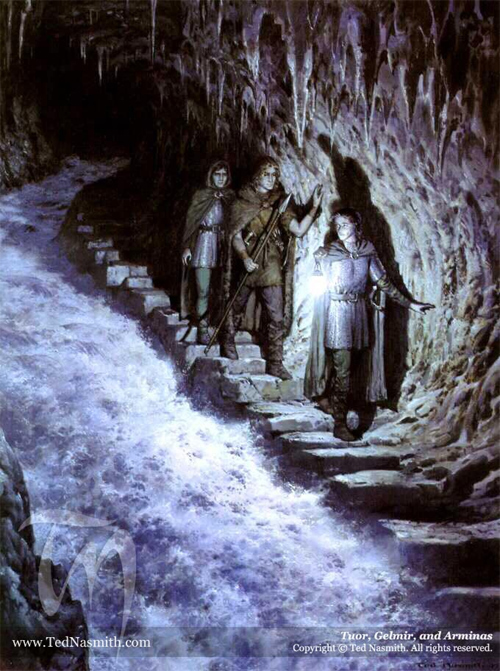
And it’s a pity The Silmarillion skips these messengers here, because they’re a helpful reminder that Ulmo has irons in several fires at any given time. (Well, figuratively speaking; more like he’s got many trawls in the sea.) Ulmo may have laid the most groundwork in Project “New Star” (i.e. his plans for Tuor’s line), but it sounds like he’s doing his best to help all the exiled Noldor as much as he can against the inevitability of a Morgoth victory. Remember, he’d given both Finrod and Turgon their city-building dreams in the first place, which in turn led to the founding of both Nargothrond and Gondolin. But even Ulmo knows that lasting is the best the Noldor can do. Remember what he’d told Turgon centuries ago: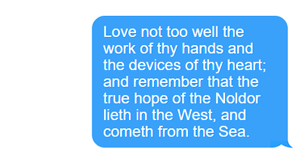
Right, so let’s get back to that true hope thread.
In refreshing contrast to Hurin’s own walking tour in the previous chapter, we’re told explicitly that Morgoth is completely unaware of Tuor and his departure from Hithlum. Not because they don’t know that there’s some outlaw hobo preying on the occupiers, just that neither Orc nor Easterling knows about this secret passage in the hills.
Tuor walks through the long and dark tunnel and emerges at last to a place he names Cirith Ninniach, the Rainbow Cleft. It’s a rocky pass through which headwaters flow toward the Sea until they become the Firth of Drengist. The name comes from the array of color produced by the foaming waters in the light of sunrise and sunset, but it’s funny that it’s Tuor himself, a Man, who gives it this name. Why? Well, like Buddy, he’s technically a human who was raised by Elves, so he’s no doubt developed a proclivity for naming everything.
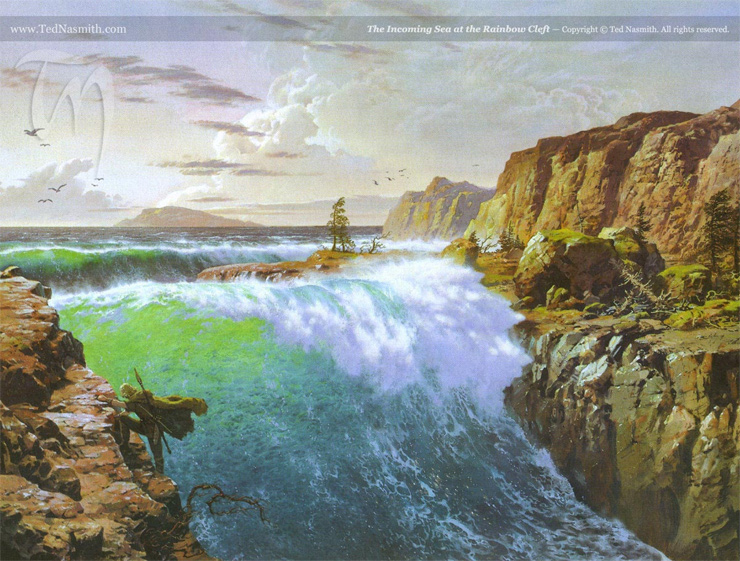
Now, Tuor is driven by divine inspiration, but he tarries on this journey like a freakin’ Teler. Taking his time, sightseeing nature, and loving everything. (Somewhere, Ulmo has got to tapping his waterproof watch.) When he reaches the actual coastline where the Firth of Drengist joins Belegaer, the Great Sea—not far from where Fëanor burned the ships and left Fingolfin’s host in the lurch—he enters the land called Nevrast.
The Sea itself inspires Tuor like nothing else. He is gobsmacked, thunderstruck, awestruck. He’s an immediate lifelong fan of the Sea at first sight, “and the sound of it and the longing for it were ever in his heart and ear.” It’s said that he was even the first mortal Man to look upon it, for none of the Edain ever came this far west. Basically, whatever happens from this point out, the Sea is in his heart.

Tuor is in no rush, and he hangs out there at the coast of Nevrast for an entire summer and more. The narrator helpfully informs us at this point that at this same time far away, Nargothrond is about to fall. The First Age has known centuries of relative peace, but ever since the Battle of Sudden Flame forty years ago, things have been on a downward slide. Even as Tuor enjoys the lonely beauty of Nevrast by the sea, things are getting dire elsewhere. Then one day Tuor gets a sign: seven big swans flying south, which he rightly takes to mean “Get a move-on, Tuor!”
In Unfinished Tales, the swans even swoop down around him and make a big ruckus. Swans can be mean, and these seven are ginormous. But I also find this part of the story amusing. Oh sure, the Teleri can tarry for years and years and no one makes a stink, but a single Man lingers for a few months and it’s a whole big thing! Men always get shortchanged.
Following the swans, Tuor comes at last to Vinyamar, the old city where Turgon and his people dwelt in their pre-Gondolin days.
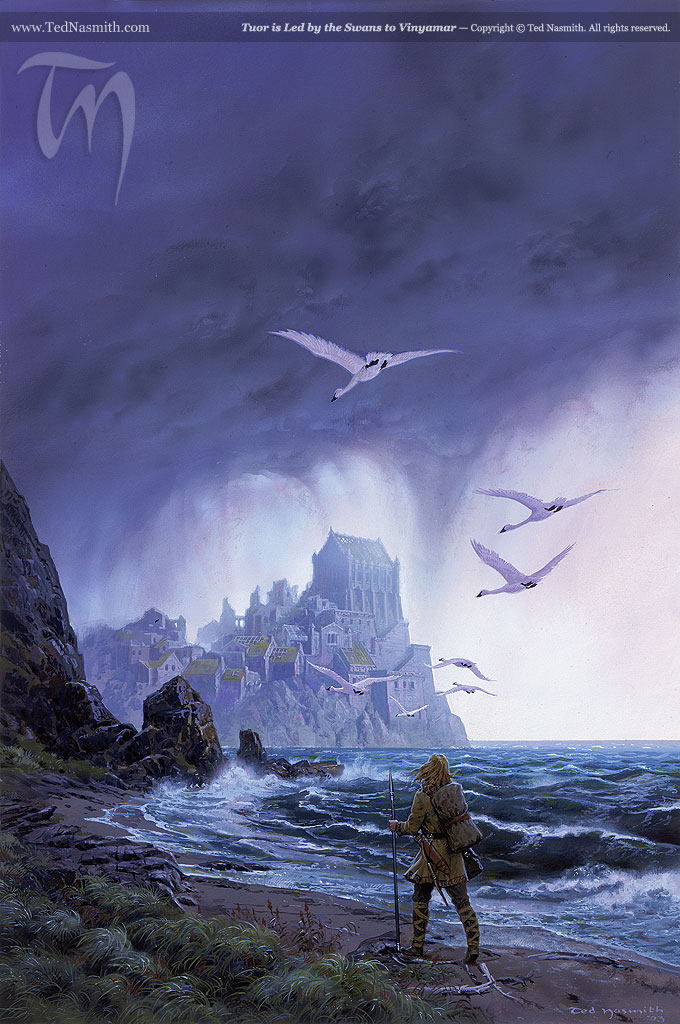
He explores the long-vacant settlement by the Sea, and before long he comes across a magnificent suit of chain mail (a hauberk), a helm, a shield, and sword, and it might as well be hanging on a mannequin (Man-nequin?) labeled “for one who shall come to warn Turgon, and from that one beyond ruin and fire hope shall be born.” For this is the very suit that Ulmo ordered Turgon to make, sized perfectly for the messenger who Ulmo’s been pushing for.
Understanding that this armor is important, if not why, Tuor puts it on then goes down to the beach. A storm rolls in from across the water, coming out of the west, and that’s when Ulmo finally steps out from behind the curtain to meet his chosen one—face to gigantic face. As a Vala who seldom assumes physical forms like his peers, on this occasion he does rise up from the waves “in majesty.” While The Silmarillion gives us nothing more than that, Unfinished Tales offers Tolkien’s earlier vision of him:
A tall crown he wore like silver, from which his long hair fell down as foam glimmering in the dusk; and as he cast back the grey mantle that hung about him like a mist, behold! he was clad in a gleaming coat, close-fitted as the mail of a mighty fish, and in a kirtle of deep green that flashed and flickered with sea-fire as he strode slowly towards the land.

I know the whole chapter is awfully short considering all that transpires, but this particular section is painfully brief for such a momentous encounter. Ulmo lays it on Tuor, revealing what errand he has called him for: Tuor must go and find the Hidden City of Gondolin and bring Turgon a final warning. He gives him a special cloak that will help hide him on the journey; between that and the uncannily bespoke armor, Turgon is sure to know that this Man is Ulmo’s prophesied messenger.

Now, the Unfinished Tales account gives us nearly all of Ulmo’s words directly, and it’s full of great insight, concerning not just the quest he’s asking Tuor to accept—it’s requested of him, not forced upon him—but also plenty of context for what it all means. The Lord of Waters’ full speech is like an eloquently worded (because Tolkien) exposé on all things Eldar. Chatty Cathy that he is, Ulmo dishes about things no mortal has ever heard before, least of all from a Vala. We’re talking the Two Trees, the Darkening of Valinor, the Exile of the Noldor, the Curse of Mandos, you name it. (Probably even the Leap of Beren!) The guy kinda just won’t shut up.
Thus is Tuor informed like no other Man. And all straight from the (sea)horse’s mouth. What stands out to me the most is Ulmo’s admission to Tuor that he, Ulmo, is “a secret voice that gainsayeth” even the other Valar—or rather, that it’s kind of his job to oppose the will of his peers at times, and that he was appointed to do so before “the making of the World.” I can’t help but feel like Ulmo’s had all this bottled up a while and needed to tell someone. So why not his new favorite mortal?
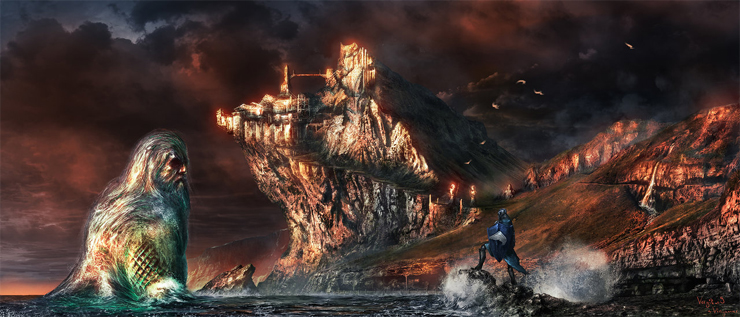
But sheesh, what a mindjob! And Tuor takes it all in stride. So why, one might wonder, doesn’t Ulmo do more than just talk to Tuor and send him as a messenger? Why doesn’t he go to Gondolin himself, or use his rivers and waters to foil Morgoth? You get the sense that he would if he could, and he’s definitely exercised his power in and around the Vale of Sirion plenty of times in the past, as well as at the Pools of Ivrin. But he admits that Morgoth’s power has grown and that Ulmo’s has diminished wherever the Dark Lord’s minions have defiled these waters (like nasty old Glaurung had).
The next day after his meeting with Ulmo, Tuor meets an Elf by the name of Voronwë who’s hanging out by Vinyamar’s vacant sea-facing wall. And he is totally that one surviving mariner that Turgon had sent out after the Battle of Unnumbered Tears, seeking Ulmo’s “true hope” that “lieth in the west.” Spared from the wrath of Ossë by Ulmo himself, Voronwë never did go back home to Gondolin. He’s strayed and tarried by the shores (as you do) for some twenty years and is somewhat ambivalent about the Sea now. He’s just sort of haunting the coast near Vinyamar like he’s waiting to fulfill a purpose….
When you know more of Voronwë’s story from Unfinished Tales, it’s a bit heartbreaking. Not only has Voronwë suffered hardship and loss, he’s fallen behind the times. When he meets Tuor, not only is he amazed to see a Man so arrayed in princely Noldorin armor and claiming to have just met Ulmo, Voronwë dares to hope that things are better now since he’s been away.
‘Long have I labored in the unrelenting sea. Tell me: have great tidings befallen since I walked the land? Is the Shadow overthrown? Have the Hidden People come forth?’
‘Nay,’ Tuor answered. ‘The Shadow lengthens, and the Hidden remain hid.’
You know you’re out of the loop when a mortal hermit is the one to fill you in. But actually, nah, Tuor has inside information now. And Voronwë rolls with it. I mean, no one just ups and claims to have met Ulmo the Mighty unless it really happened. He agrees to lead Tuor to Gondolin but also tells him that, by Turgon’s own laws, there’s no way they’re just going to let a mortal Man in. But Tuor’s politely all, “Hello? Messenger of Ulmo here, sporting the hauberk and helm that Turgon himself commissioned? He’ll have to let me in.” But I’m paraphrasing.
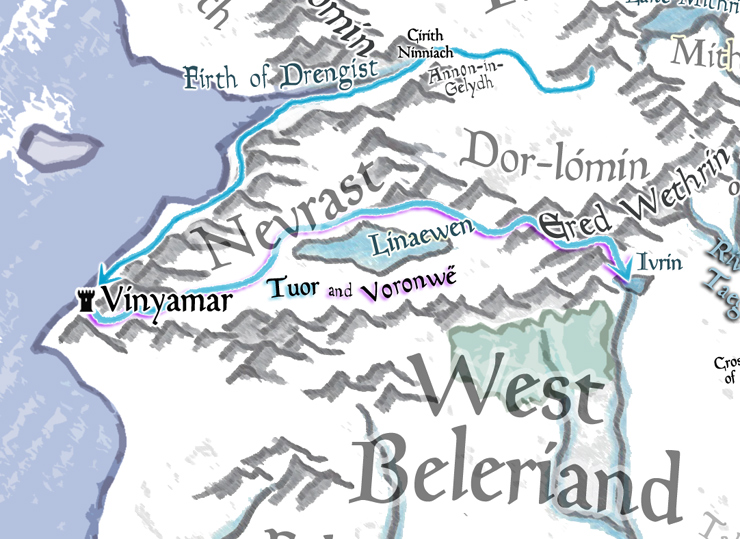
They journey together back to the east, following along the Mountains of Shadow. This is during that especially fell winter that Morgoth unleashed on the land after Nargothrond’s ruin. Tuor and Voronwë arrive at the Pools of Ivrim, those springs that were once blessed by Ulmo, only to discover that it’s all frozen and fouled up. Which is, of course, the work of the Dragon of Angband, Glaurung, who’d defiled the place like a rock star trashes a hotel room. It’s here in this frigid mire that Tuor and Voronwë spot another traveler hiking past in a different direction: a Man with an interesting black sword. But the guy is oblivious to them, hurrying north, and seems to be dealing with some shit.
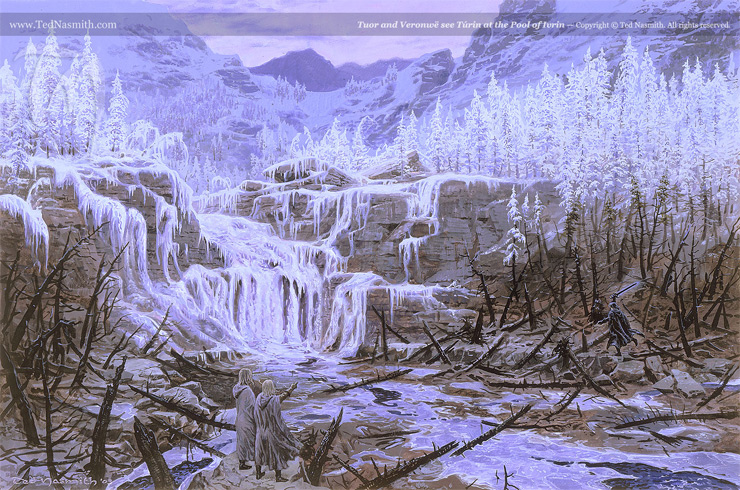
What up, Cuz?
But no, they let the mysterious, dark-haired man go on without bothering him (and we barely dodge a crossover episode!). Which is probably a very, very good thing for our two travelers. Wouldn’t want to see something bad happen to poor Voronwë, for example. Túrin Turambar has a bad track record with Elven friends. Accidents happen.
So on they continue through the harsh winter, across the Vale of Sirion and many Orc-infested miles. Tuor’s got his shadowy Ulmo-cloak, and Voronwë is naturally stealthy. At last the Encircling Mountains rise before them. Had Tuor not procrastinated in Nevrast before reaching Vinyamar where Ulmo waited for him, he’d have started on this journey much sooner and gotten ahead of this season of death. Ulmo had even said as much to him:
Haste thou must learn, and the pleasant road that I designed for thee must be changed. For my counsels have been scorned, and a great evil creeps upon the Valley of Sirion, and already a host of foes is come between thee and thy goal.
Lest we think that even an obedient goody-two-shoes mortal is just strolling easily along a predetermined path of destiny. Ulmo may have attempted to roll out a fate-lined red carpet for Tuor, but being a Man, Tuor’s kind of screwed that up. How aggravatingly human Tolkien’s Men are, and how slippery their free will!
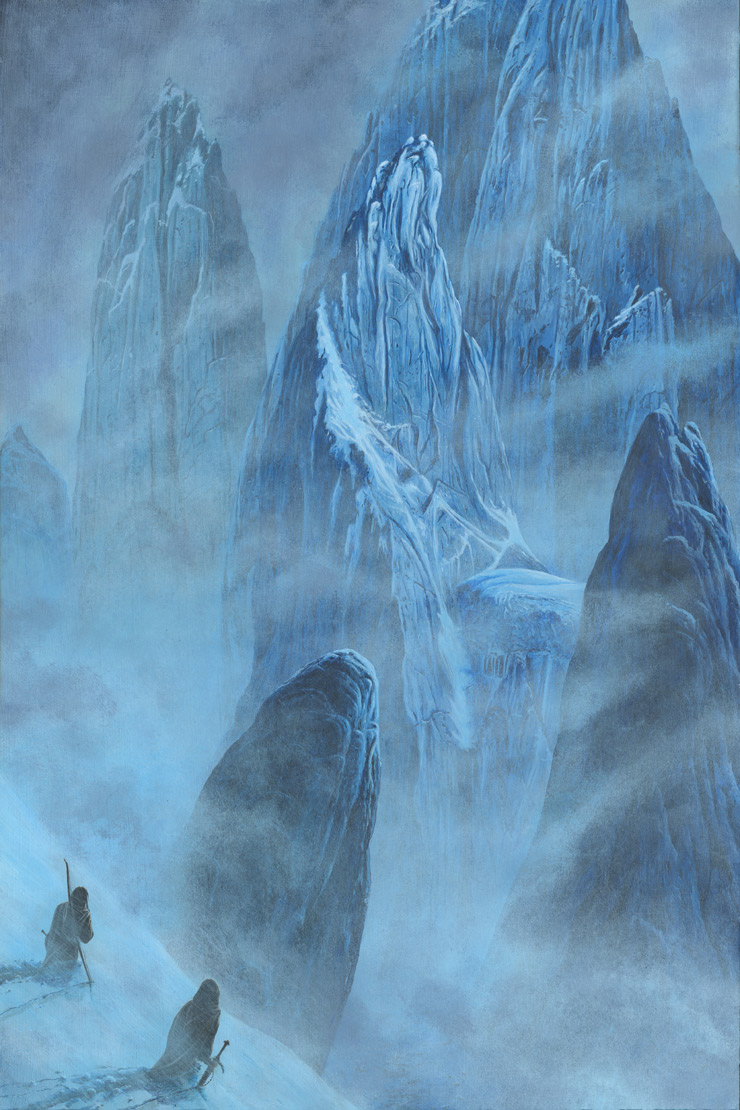
And then the day comes at last. Voronwë leads them to the secret entrance in the Echoriath, the Encircling Mountains, where Gondolin’s hidden sentries take them in like well-treated prisoners. Once you’ve discovered the way in, there’s no going out again.
The gate-wardens are surprised to see a Man at their doorstep, but they quickly realize this one’s business has a capital B. Not only is he wearing storied Elf-togs, a cool shadow-cloak, and a Noldorin sword, but he claims to be the son of Huor, one of the two mortals who had actually come to (and somehow managed to leave from) Gondolin years ago.
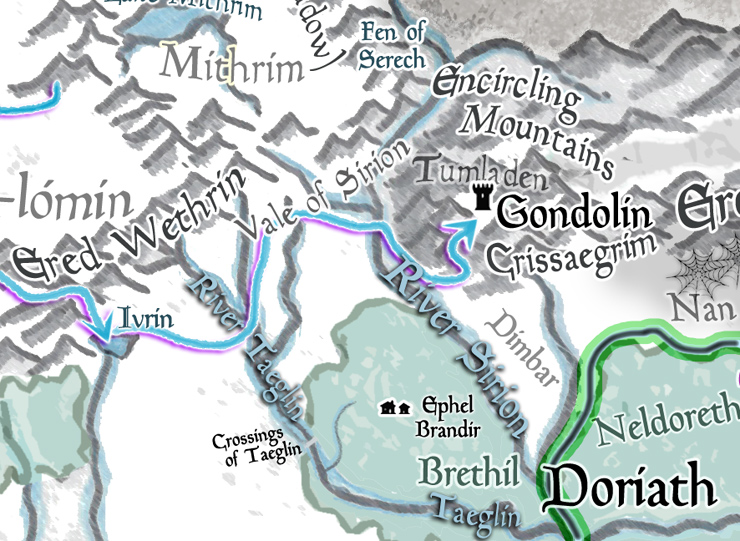
And this is where Tuor and his ex-mariner Elf-guide are escorted through a long ravine with seven über-cool gates, none of which get any mention in The Silmarillion—but Unfinished Tales can hook you up with the details. They’re seven fortifications of wood, stone, bronze, iron, silver, gold, and steel, illustrious yet formidable gates an army would have a hell of time getting through, even if they found a way in through the mountains.
Tuor finally gets a look at the Hidden Valley and its amazing centerpiece, the glorious city of white stone that was constructed in memory of the Noldor’s first city of Tirion back in ancient Valinor. The captain and gate-warden, Ecthelion of the Fountain, whom we first saw in action guarding the retreat of his king in the Battle of Unnumbered Tears, orders a blast of trumpets that is then echoed back from the walls of the city. I assume he’s got some signal system in place, and this particular sequence might mean FYI, A Serious VIP Has Been Admitted.
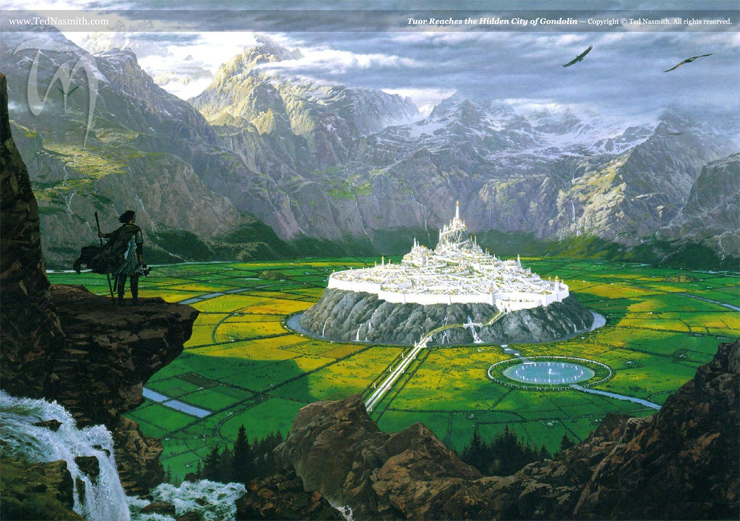
Across the fields and up many stairs, Tuor is escorted into the city. There are shining fountains all over the place. This place is fair indeed! Then he comes to the Tower of the King, the centerpiece of Gondolin, where he sees images carved depicting the Trees of Valinor. (Hey, Ulmo told him about those!) Then he’s brought before the throne of Turgon, High King of the Noldor, who has got to be holding his staff of doom like a mofo in this moment.
And though we’re not explicitly told this here in the text, Turgon’s got a memorable sword that’s surely hanging from his hip right now. Thousands of years in the future, Tuor’s own grandson will say:
This, Gandalf, was Glamdring, Foe-hammer that the king of Gondolin once wore.
Also present is Turgon’s daughter, Idril, “fairer than all the wonders of Gondolin.” And also Turgon’s nephew, Maeglin. Remember these two? This is also a good time to remember the tale of Maeglin’s dysfunctional family.
Now that Tuor’s long journey is at an end, he relays his warning to Turgon, which was seemingly the purpose of his coming. And it’s basically: hey, remember the curse of Mandos and the Prophecy of the North? It’s reaching a head. The works of the Noldor are not going to last, Turgon, so it’s time to make like an Ent and leave. Follow Sirion down to the Sea…and survive! Thus spake Ulmo.
Now, Turgon remembers what Ulmo told him. I have think that he’d have had it cross-stitched and framed and hanging on his foyer wall by now. It was the final take-away from his own conversations with the Lord of Waters, after all.
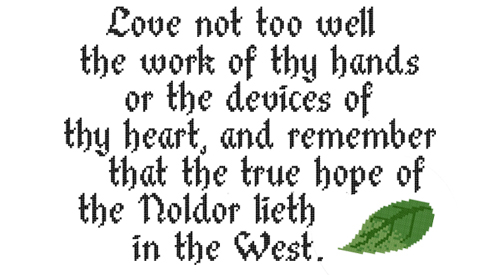
Plus, the arrival of Tuor in that signature armor gives him pause. This young mortal is obviously important. And Turgon also remembers the seemingly prophetic words of Huor, the guy’s own dad, about a “new star” arising somehow from the two of them (Huor and Turgon). So this Tuor fellow needs to be well cared for. He’s practically family.
But you know who doesn’t care one bit for this magical mystery Tuor, nor his heritage, his message, and his insta-favor with the King? Not one tiny bit? Maeglin, of course! All these years later, the half-Noldo-half-Sinda still has the hots for Idril, but he especially wants the throne she surely comes with. Maeglin hadn’t liked Huor when he visited; he sure as heckfire doesn’t like his snot-nosed kid. So the creepy son of Eöl—you know, the Dark Elf who was executed here in Gondolin more than a century ago for the murder of Maeglin’s own mom—makes sure to oppose Tuor in all counsels. And Turgon does listen to what everyone has to say, and he thinks hard about what to do.
Now, this is the pivotal moment for Gondolin and probably all of Beleriand. Turgon considers all he’s gone through up to this point: all the years of labor in building Gondolin, all the shade he might have been thrown for his unswerving laws, and the ever-searching malice of Morgoth, who he has managed thus far to elude. And so Turgon decides that Gondolin is strong enough to hold against Morgoth “though even a Vala should gainsay it,” and that its secrecy makes it unassailable. But what if I really, really, really love well the work of my own hands, Ulmo? Have you considered that? Gondolin’s doing fine, but thank you very much for your concern, old buddy. We got this.
Turgon has become far too proud to just cash in fair Gondolin’s chips now. Yet he was there when the Doom of Mandos was pronounced, and remembers well Ulmo’s warning that it would find him eventually, and that treason shall “awake within thy walls.” And so, as if he can simply wall up fate, Turgon has that outer secret door (the one Voronwë led Tuor to) blocked up; it’s no longer enough that it’s just hidden. Now there’s no more going outside the valley with messengers or scouts. For anybody. This is a total quarantine situation now. Turgon, like many ill-fated leaders in the past, goes all isolationist. Gondolin first!
And the fact is, things are fine for some years after this point. Things are okay. Tuor can’t change the mind of Turgon, so he stays and lives in Gondolin (as if leaving were even an option). But he becomes enamored of its people, their culture, and their wisdom (the current wisdom of the king notwithstanding). All of his already heroic skills are honed in the presence of so many Noldor. And others—even before Gondolin, Turgon’s people mixed with Sindar. Voronwë himself came from such intermarrying Elves.
More importantly, Idril falls for Tuor, and he falls for her. Their romance, while seemingly understated in the narrative, certainly portends many events and people to come. Whereas every other time the union of a Man and an Elf is a huge deal—Beren had to get a Silmaril, Aragorn will have to unite kingdoms and bring down Sauron—Turgon is immediately okay with his daughter marrying Tuor (he’s become fond of the chap). But mostly it’s because of that “new star” prophecy. Good on you, Dad!
Celebrations are made as Tuor and Idril tie the knot, and now we have “the second union of Elves and Men.” In the year 503 since the arrival of the Noldor on Middle-earth and the rising of the Moon and Sun, they have a baby: Eärendil. Now, we’ve received a few hints about the significance of this Eärendil the Blessed in the past, but he is the one Huor’s soothsaying referenced. And he’s why, even though Turgon has shrugged off Ulmo’s warning, Tuor’s coming to Gondolin is still important.
So in little Eärendil (ay-ah-REN-dil) we’ve got the blood of the Noldor mixing in with the three houses of the Edain. He’s the ultimate Mutt of Ilúvatar!
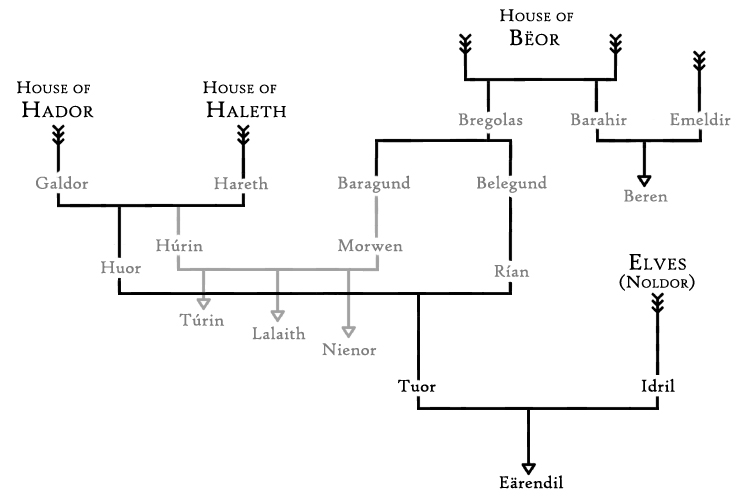
In any case, now Maeglin is really pissed. Tuor has removed his hopes for both Idril and the throne. Pride and jealousy seethe within him, which certainly doesn’t bode well.
Speaking of pride and jealousy, we cut over to Morgoth, who around this point in time has been busy grinning over the murder of Thingol, the departure of Melian and her Girdle, and then the death of the last king in Menegroth, Dior, and the destruction of all of Doriath itself. Two of the most elusive Elf-realms, Nargothrond and Doriath, have now fallen. He’s seriously jonesing now for Gondolin’s ruin.
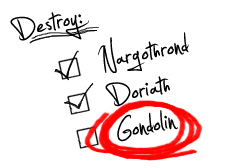
He even knows roughly where it is, now: somewhere around the Encircling Mountains where Húrin had called out for Turgon. But every time he sends Orcs in to poke around that region, those Manwë-be-damned Eagles pick them off (then possibly pick their bones). No one can report back to him. So Morgoth’s still biding his time, trying to figure out a way to crack that shell. It’s so close—almost hidden in plain sight!
Meanwhile, two things are taking place without the knowledge and against the will of Turgon, High King of the Noldor. The actions, rather, of two people.
Let’s start with Idril. We’re told that the Gondolindrim princess was “wise and far-seeing,” as many royal women in Middle-earth seem to be. While nearly everyone within Gondolin is enjoying peace, she is troubled and forsees evil to come. So she devises a secret escape route out of the hidden valley, letting only a select few in on this contingency plan (probably only those who help her tunnel it out). No way would her daddy approve this; he’d consider any way out to be a way in. But she’s a clever girl and knows what needs doing. And note, by the way, that she’s not just helping someone else. This project is all her—it’s not even clear that she lets her husband, Tuor, in on this until the day the secret way is actually needed. Idril may be the daughter of the King, but she’s not some pampered Disney princess. Idril’s a Calaquendi Elf, born in Valinor, who survived the march with her kin across the Helcaraxë, on foot, and in that frozen hellscape lost her mother. Idril’s tough, and now she’s overseeing some surgical excavations on the down-low. Pretty badass.
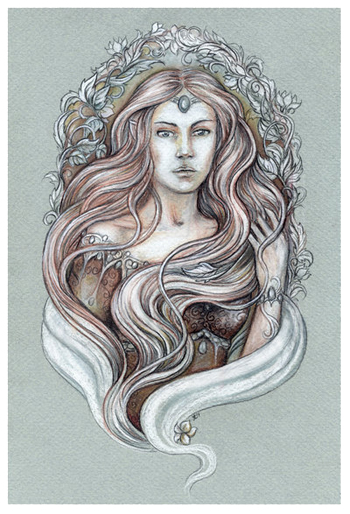
Then there’s Maeglin, Idril’s sinister cousin, who in the past has often gone out into the mountains in search of metals to mine for his smithwork—which is all well and good by itself. It was even his craftsmanship that helped the Gondolindrim warriors when “Turgon opened the leaguer of Gondolin” and marched out with ten thousand at the Battle of Unnumbered Tears. But whatever points he may have stacked up from his martial contributions are about to be sold out with interest.
See, he starts going even further afield into the mountains than usual, venturing beyond the boundaries laid own by Turgon’s laws. He takes to going out with even less company, or even alone, not unlike…say….Fëanor and his sons back in Aman….or Melkor himself in the Void. Well, one day, “as fate willed,” Maeglin runs into some Orcs and they manage to snatch him up. An Elf fresh from Gondolin, probably still smelling of the hidden valley beneath all that mining dust. A prize indeed! The Orcs drag him back to Angband in chains and he is tortured, if not maimed. He’s Moriquendi, but he still toughs it out. Yet Morgoth proposes a bargain between the two of them, and Maeglin accepts it. Thus does Maeglin fulfill the warnings from long ago about treachery awakening within Turgon’s walls. Even worse, this is the first time any of the Firstborn Children of Ilúvatar has ever allied with Morgoth since…well, since he’s been Morgoth, the Dark Enemy of the World. Even Fëanor would not have done this.
But alas. Mandos called it. Ulmo called it: the treachery is coming from inside the Hidden City!
Peril draweth nigh indeed. Maeglin has ratted Gondolin out, and for it Morgoth promises him the lordship of Gondolin once it’s been taken. Hey, look, Morgoth’s made another promise! But this time I’m sure he’ll keep it. Definitely, definitely.
And just in case anyone wants to give Maeglin the benefit of the doubt, or figure he’s just stuck in a bad situation—and yeah, being captive in the Iron Hell that is Angband is a terrible predicament—Morgoth lets him return to Gondolin so as not to arouse suspicion. And so that Maeglin can strategize from the inside. But right there in his uncle’s court, with ample opportunity to renege on Morgoth’s deal, he stands “with smiling face and evil in his heart.” He’s crossed over to true villainy. There’s no second-guessing this. Maeglin is in bed with Balrogs who would tear Elf toddlers apart.
Speaking of Elf children, it’s after little Eärendil has turned seven that Morgoth makes his move. He’s gathered his armies for a single-minded, brutal assault. Balrogs, wolves, and Orcs aplenty set out from Angband, followed by numerous dragons of Glaurung’s brood. The fire-drakes still can’t fly, but they sure can traverse mountains. This army of darkness comes from the north, flowing over the hills and mountains during a “time of festival” (a Morgoth classic!) in Gondolin. Going nowhere near the original hidden door and the seven magnificent gates.
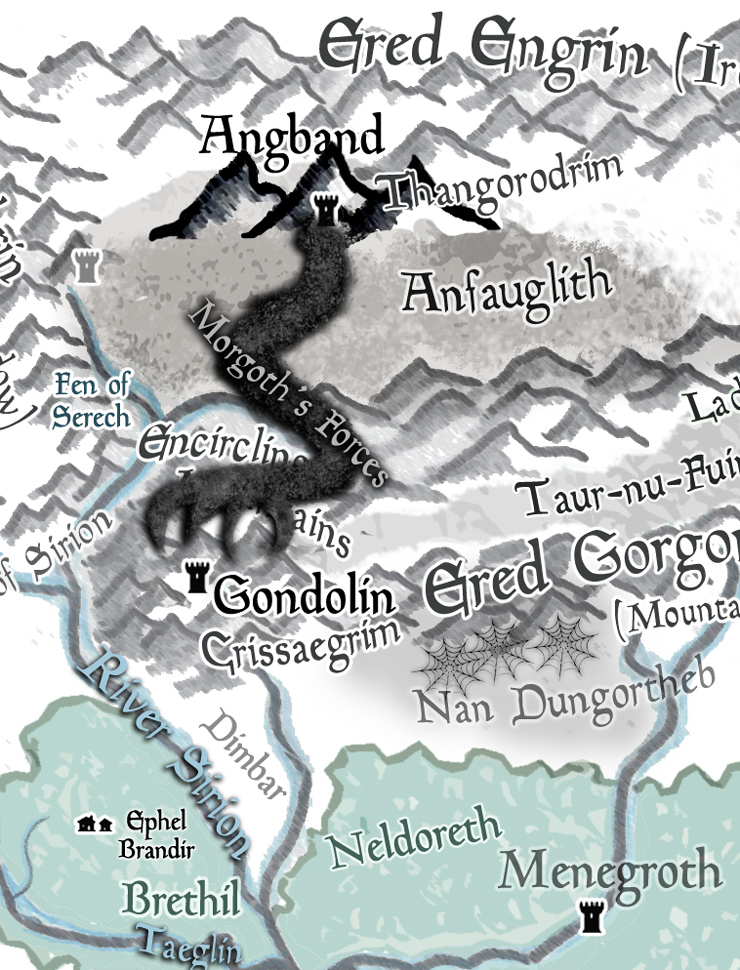
Now, I don’t know where the Eagles are at this point. Why don’t they spot the massive army of monsters and give Turgon warning? We’re just not told. Given the brief wording of all of this, we could simply chalk this up to Maeglin’s helping out from the inside and making sure the day chosen is a day the Eagles aren’t around. Who says they monitor the skies around Tumladen 24/7? Maybe Thorondor and his subjects happened to be away that weekend at CloudCon or something.
So it’s not until the forces of Morgoth have come pouring down the north end of the valley that Gondolin’s people take notice of them and start to mount a defense. But this is an overwhelming tide of Orcs, Balrogs, wolves, dragons, and who knows what else; I mean, are there trolls!?! We got barely a glimpse a few chapters back. Either way, the city is in serious trouble. The enemies climb and crawl up the hill and over the city’s high walls. The dragons could even have some form of proto-wings at this point—Morgoth is still working to breed those in somehow—but they can’t fly yet. Yet that fact hardly limits their strength and size, nor their devastating fire. They coil about the towers and bring them crashing down. This isn’t seizure, it’s destruction.
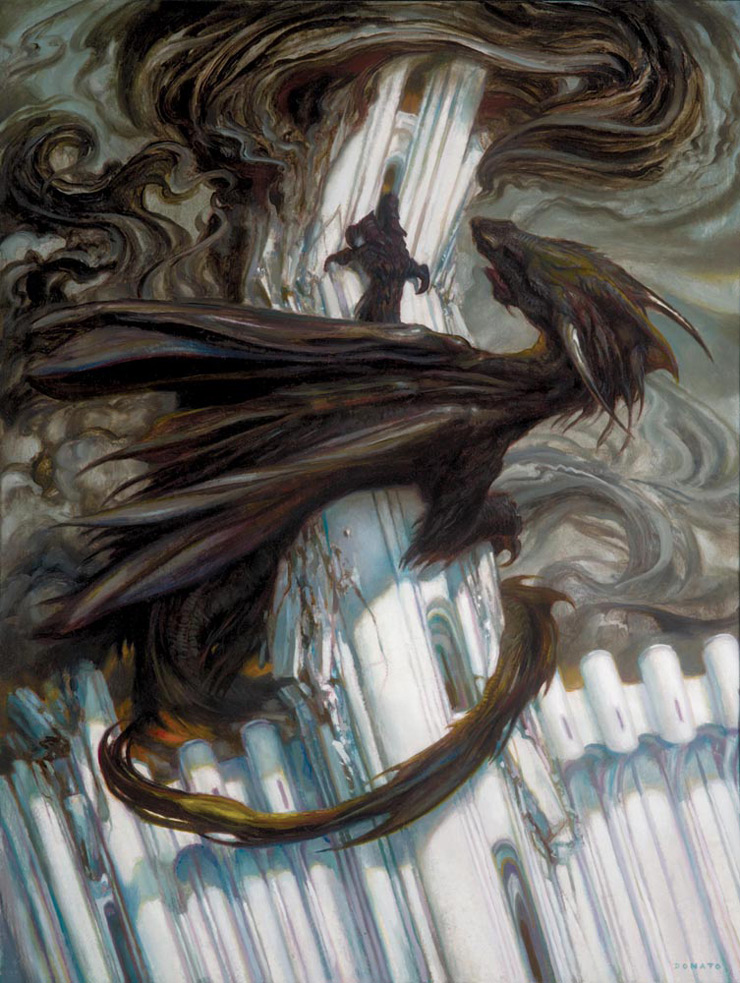
And there’s just no stopping this tide of evil. There is only, at best, surviving it. We’re given only the briefest of highlights of this devastating siege, a massive contrast to the scads of details The Book of Lost Tales, Part Two gives us, but it’s important to note that in that earlier account, there are elements not stylistically compatible with Tolkien’s later vision of Middle-earth. One fascinating example: In that version, Morgoth sends not only his living minions but also mechanical “monsters such as have only at that time been seen and shall not again,” constructs of iron, copper, and bronze that seemed to combine both siege engine and transport for not only Orcs but also Balrogs. We’re talking Middle-earthen tanks and armored personnel-carriers. Still, there’s no mention of such monstrosities in The Silmarillion.
But we are told that Ecthelion of the Fountain squares off in the King’s square against Gothmog himself—the evil Maia responsible for the death of Turgon’s elder brother, Fingon, and who brought low the great Fëanor long before. The valorous Elf captain takes down the Lord of Balrogs single-handedly like the Calaquendi boss that he is, though he gives up his own life to achieve this victory (a fact that Tolkien actually “spoiled” for us many, many chapters ago).

Going back to The Book of Lost Tales, Ecthelion’s feat actually involves him impaling the Balrog in the chest with his spiked helm, grappling and pulling them both down into the square’s deep fountain, Gandalf-style;
and Ecthelion sank steel-laden into the depths, and so perished the lord of the Fountain after fiery battle in cool waters.

A very metal death indeed!
The King’s own palatial estate is then defended by its household guard, and by Turgon himself at the pinnacle, but to no avail. The entire tower comes crashing down, with the king inside, as others look on. Turgon is slain not in hand-to-hand combat, but in the building’s collapse…
and mighty was its fall and the fall of Turgon in its ruin.
Yet he goes down fighting, like everyone who dies in this battle. The Book of Lost Tales even has him finally admitting Gondolin is a loss, consenting to the flight of Tuor and Idril with as many as they can take with them. But Turgon himself chooses to stay and keep fighting, like a captain going down with his ship. He casts away his crown as if in abdication, and calls out victory for the Noldor to spite the gathering Orcs. But ultimately, multiple dragons tear at the base of his tower and it crumbles “with a great clangour.”
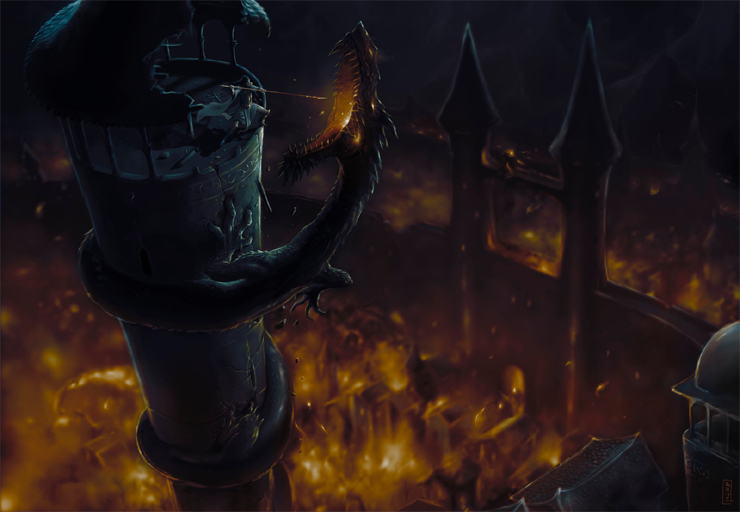
Too well did Turgon love the work of his hands and the devices of his heart. But though all his people are in dire straits, his own spirit is loosed to return to the Halls of Mandos and Valinor, where he can at least be reunited with his wife, who perished in the crossing of the Helcaraxë. It’s been more than five hundred years since he’s seen her.
And oh, now he’ll get to see his sister, Aredhel, again. There’s so much to talk about….
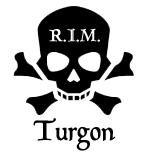
But we’re not done yet! Battle rages on in the Not So Hidden Valley.
At the time of the start of the siege, Tuor was not with his wife and son. He now has to fight his way to them, only to find that they’re being manhandled (Elfhandled?) by the dastardly Maeglin—toward whatever fate he’d intended for them. The Book of Lost Tales account does not let us wonder: he drags Idril by the hair, intent on making her watch him cast her son, Eärendil, over the battlements and into flames below. Maeglin has truly eclipsed his own father now.
And yet, it takes one to know one: Maeglin surely sees by now that Morgoth is an inimical asshole and liar. What good is being the lord of Gondolin if the city itself is busted up and defiled by the monsters of Angband? Its spires are being torn down, its streets cracked, its fountains broken, its people roasted and slain. Sucks to be Maeglin right about now, yet frankly, I think he deserves little pity. There’s no victory on the table for him—only repentance, at best, which he doesn’t even seek.
Tuor reaches Maeglin on the high walls and they do battle, the former no doubt clad in Ulmo’s hauberk of righteousness and the latter armored in Eöl-black. “Here shall you fail of all your hopes,” Maeglin’s dad had said to him with his prophetic final words, “and here may you yet die the same death as I.” Tuor fulfills the Dark Elf’s prediction for him: he gets hold of Maeglin and hurls him out over the wall, where the Elf not only bangs against the cliff as he falls, but then drops down “into the flames below,” flames which his own lustful dreams of power had brought to this city.

I imagine the spirit of Eöl is there waiting for him in the Halls of Mandos, such that the first thing the bodiless Elf perceives is the mocking and slow clap of his father. “Did I call it or what, son?”
Tuor’s got his wife and kid back now, but at this point, it’s all just damage control. Tuor and Idril together take charge and gather up “such remnants of the people of Gondolin” as they can find in the chaos and death around them. With them is that other notable captain, yellow-haired Glorfindel—who is absolutely the same Glorfindel who meets Strider and the hobbits on the road to Rivendell and helps to ward off the Ringwraiths thousands of years from now. He’s the one who Frodo sees as a “white figure that shone,” seeing him, as Gandalf explains, “as he is upon the other side.” Other side of what? Well, read on.
Now does Idril’s preparedness come into play: she and her husband lead the people through that passage at the northern end of the valley that leads into the mountains. And much like sneaking the One Ring into Mordor will one day be a great surprise to Sauron, here no one would have guessed a secret exit would go out northward towards Angband. Boy, does she ever deserve a Surreptitious Escape Route merit badge for this moment: Idril’s secret passage is secret! In fact, the steam of Gondolin’s many fountains amidst all the burning provides the escapees the very smokescreen they need to flee to safety.
Turgon is dead, and the dream city fashioned in the memory of Tirion is utterly ruined.

But Idril’s secret way out isn’t an easy one.
Nonetheless they came hither, and beyond hope they climbed, in woe and misery, for the high places were cold and terrible, and they had among them many that were wounded, and women and children.
Seven-year-old Eärendil is among these, too. Soon the refugees come to an especially narrow and deadly pass, with a sheer wall of mountain on one side and a whole lot of open sky on the other. And this is when we discover that Morgoth held back a portion of his army in watchful reserve: a whole swarm of Orcs and one Balrog were placed in the hills around this region on the off-chance that any Elves manage to sneak out. So now they’re in real trouble. The refugees are already weak.
And that’s when valiant Glorfindel takes one for the team. Not just because he presents himself as the Balrog’s target, drawing it away from his people, but because he’s a badass warrior and he can actually deal out some hurt to this Scourge of Fire. He duels the great demon of fire upon a pinnacle of rock and in their epic battle, he takes it down with him into the abyss, Gandalf-style.
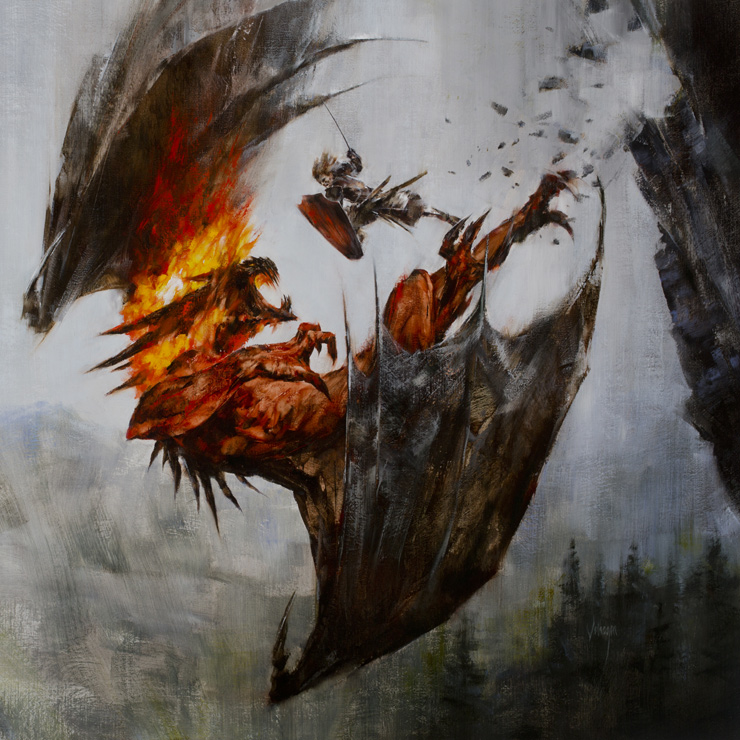
Your wings (if you even have any) will not avail you, flame of Udûn (Sindarin for “hell”)!
But yeah, Glorfindel essentially pulls the first “fly, you fools” moment (long before it was cool), taking on a Balrog in a narrow place and sacrificing his own life to save everyone else. Considering that Glorfindel is one of the very few known Elves to be re-embodied in the Halls of Mandos and will actually be sent back to Middle-earth later, the Maia who will someday be called Gandalf unquestionably learns about this moment.
And this is when the Eagles come swooping in—back from their convention, I guess?—to pick off the Orcs that yet remain in the refugees’ way. They’re either pecked and torn to death or else dropped into the open air as well. In this way, none of Morgoth’s spies are able to report back to him about this batch of Gondolin survivors. Thorondor, King of the Eagles, recovers Glorfindel’s body from the ground far below and the people do him honor, placing him in a cairn of stones.

Tuor leads the refugees out of the mountains and then far to the south where the River Sirion passes through Nan-Tathren, the Land of Willows, near the Sea. This far from Morgoth’s domain, Ulmo’s own influence remains strong, so this is where they all camp out and rest up, weary and sorrowful as they are. Though they heal back physically, being hardy First Age Elves, grief stays with them for all that they’ve lost. They feast in memory of Gondolin, they mourn, they sing for its glory and its tragedy. Elf stuff.
Tuor has come a long way since he was a fosterling in Hithlum, then a loner outlaw, then Ulmo’s protégé. Since coming to Gondolin and fulfilling that errand, he’s become a truly great warrior, and a husband, and a dad. During this years-spanning aftermath, he even composes some music for his son, Eärendil, that tells of Ulmo’s arrival on the shores of Middle-earth. He doesn’t sing about himself—remember, he’s humble—but about the Lord of Waters, and the Sea.
And still the Sea calls to him. So he and Idril lead the Gondolindrim down to the Mouths of Sirion, which is where the refugees from Doriath had came not so long before. Among them is Elwing, daughter of Dior, granddaughter of Beren and Luthien, great-granddaughter of Thingol and Melian! I bet she’ll make a fun playmate for Eärendil, too. Both Half-elven kids have been through some rough stuff and have a lot in common.
The Eldar of Beleriand are not so numerous now, but those that have made it this far are at least hanging in there. A new High King of the Noldor is named, now that Turgon is dead: Gil-galad, son of Fingon. Círdan and his own much-reduced people are also nearby.
Morgoth is none the wiser about these important people. All he knows is that he’s just wiped out the last of the great Elf-realms. Bully for him.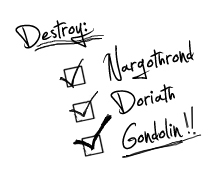 And all it cost him was a few Balrogs, maybe a few dragons, and a buttload of Orcs. No biggie; he’ll make more. The point is, he’s won. Again. So much winning! One wonders if he and his slaves will ever get tired of winning…
And all it cost him was a few Balrogs, maybe a few dragons, and a buttload of Orcs. No biggie; he’ll make more. The point is, he’s won. Again. So much winning! One wonders if he and his slaves will ever get tired of winning…
But Morgoth doesn’t care about the remaining sons of Fëanor. Even at their strongest they never came after him—not really. In fact, their ridiculous Oath has only led them to slaughter other Elves. At this point he’s all too happy to have lost that one Silmaril—look what it’s bought him! Now, who knows if he ever learns about this pathetic little community of mixed Elves down by the seashore near the Bay of Balar, with their silly little ships. If he just waits a bit longer, those sons of Fëanor might even wipe these people off the map, too. Maybe the Eldar problem will solve itself now that they’ve been whittled down.
Especially those damn Noldor!
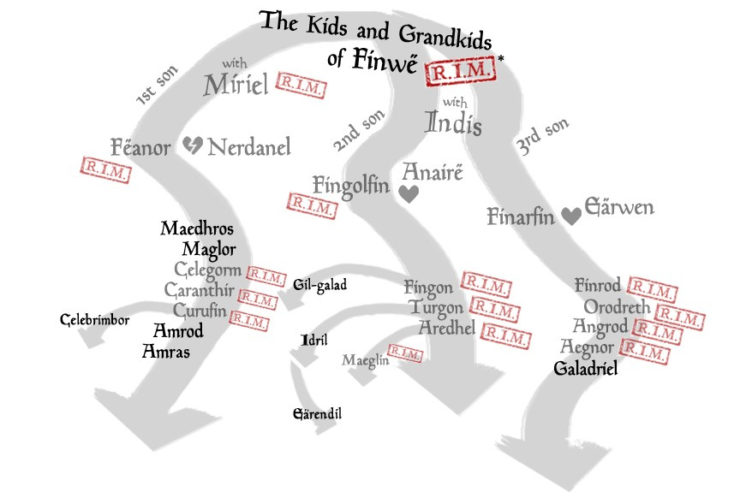
So we cut back to Ulmo. As the most proactive of the Valar, he shows up in Valinor (not something he generally does) and entreats the others, especially his old friend Manwë, King of Arda, to request a forgiveness for the Elves. Hasn’t Morgoth done enough to them already? Nargothrond’s down, Doriath’s kaput, Gondolin’s finished. Stick a fork in the Eldar of Middle-earth. They are done!
But Manwë won’t move. Not yet.
The wise have said that the hour was not yet come, and that only one speaking in person for the cause of both Elves and Men, pleading for pardon on their mis-deeds and pity on their woes, might move the counsels of the Powers; and the oath of Fëanor perhaps even Manwë could not loose, until it found its end, and the sons of Fëanor relinquished the Silmarils, upon which they had laid their ruthless claim.
So we’re not there yet. We need someone to go to Valinor in person.
Meanwhile, Tuor grows older. He’s married to an immortal Elf, to whom a few years mean almost nothing, but he’s looking gray and their son is growing up faster than any Elf. So one day Tuor builds a ship—easy enough with Círdan’s folk around—which he names Eärrámë (possibly just to see how many diaereses he can cram into a single word). Then presumably after a melancholic, not-all-tears-are-an-evil sort of farewell to their son, Tuor and Idril set sail together for the west. Rather, the West, out across the Great Sea and never back into anyone’s line of sight ever again.
Why? Their end is certainly mysterious. Are they seeking Valinor? (Which would, at this time, be in vain.) I don’t think so. Since the moment he first looked upon the Sea, Tuor longed for it, even for “the depths of the realms of Ulmo.” I think he’s seeking retirement with his pal Ulmo, and his wife is on board, too (figuratively and literally). And since no official word ever comes back of the fate of these two, we’re left guessing. The Elves speculate, though, as Elves do, and in their songs they submit that Tuor was “numbered among the elder race” and somehow joined with the Noldor, of which his full-blooded Elven wife was exactly half. But in doing so he was forever sundered from the fate of Men. Tuor broke a lot of molds.
For more of an all-in-one treatment of Gondolin and the Iceberg of Doom that Turgon waited too long to veer from, consider the imminent release of The Fall of Gondolin!

In the next installment, we come at last to the end of the Quenta Silmarillion (though not the book itself) with “Of the Voyage of Eärendil and the War of Wrath.” Front and center will be Tuor and Idril’s kid, not to mention Dior and Nimloth’s kid, a very special ship, and a whole lot of vengeful Valar.
Also….Tulkas SMASH.
Top image from “Ulmo and Tuor” by Daniel Pilla.
Jeff LaSala has so many questions about Ulmo! What are all his powers, his limitations? Does he think about Middle-earth all the time or does he set aside a certain portion of the day? How tall is he and what’s his shoe size? Tolkien geekdom aside, Jeff wrote a Scribe Award–nominated D&D novel, produced some cyberpunk stories, and now works for Tor Books. He is sometimes on Twitter.











Well, Maeglin may be Goth, but Melkor is … more Goth.
Very nice!
I always pictured Elrond identifying Glamdring and saying “That belonged to Grandpa, I’ll take it please.”
I also love the idea of Valar door-to-door missionaries:
“Can I talk to you about Nienna? No? I feel sorry for you on her behalf”
“Do you know Mandos? You will…”
So who does the sword Orcrist belong to?
“This, Gandalf, was Glamdring, foe-hammer that the King of Gondolin once wore.”
What, he couldn’t remember the guy’s name? Elrond must have been getting old.
Everything about Tolkien’s languages is amazing, and they sound so much like what they mean, and also relate to real languages in an interesting way, but there is one word that has always bugged me–Nargothrond. It just doesn’t sound right to me. I realize it has a dwarven root, but it’s such a dissonant and ugly word that it doesn’t seem like one elves would use for a beautiful stronghold. It’s difficult to say, and seems a bit ominous to my ear.
But hey, one word out of, I don’t know, 3,000 is a pretty good ratio from my point of view.
Does anyone have an appreciation for the word Nargothrond, or perhaps agree with me instead? I know it’s weird to single out and write about, but I wanted to throw this out there and see if anyone else has something to say about it.
I’m about to finally start reading it for myself tomorrow and you’re practically already at the end. Clearly I spent too much time tarrying.
I think we all know that despite being an amazing book, The Hobbit‘s account is a little rough around the edges when it comes to the larger legendarium. I think we have to give Tolkien a pass on that. I think he’d have made Elrond a little more eager to hold Glamdring if he realized that the sword was his great-grandfather’s, yeah. Especially if it hadn’t been seen since the collapse of Turgon’s tower.
@5: Yay, get reading!
@@.-@: Re: Nargothrond. I rather like it. And it seems fitting to me that of all Elf-cities, the one that includes Dwarven elements in its name would be the one that Finrod established. The Dwarves who worked for him liked him. He liked them. I continue to assert that he’s the Fred Rogers of Arda. I doubt he’d have called them Stunted, or that their language was “unlovely.” And look, Finrod might very well have met Aulë in person; I think he’d have a far better opinion of both Dwarves and their language (which they got from Aulë) than many other Elves.
I love these so much – learn so much about how the world is put together, even if I do wonder sometimes if having all of what are essentially notes for his lord of the rings saga is a good thing. Still I enjoy reading them.
Jeff, just wanted to let you know how much I’ve been enjoying these rereads. The maps and family trees are especially helpful.
There’s a bit in this chapter about Turgon closing his ears to news from the outside. Maybe that included news of an army headed his way? In Lost Tales 2 he’s getting more and more stubborn and sure he can last alone of all the Noldo strongholds. There’s also the amazing (to me) bit of 24 hours or so after the attack starts Thorondor finally noticing the uproar – which given the vivid descriptions of flame, steam, smoke, noise is really hard to believe – anyway he wakes up and pays attention and saves Glorfindel’s body. Maybe the winds were all blowing the wrong way due to the Doom?
Little Earendil is given a moment to shine in it, too. He bites Maeglin’s hand hard enough to draw blood.
Yes! I was so tempted to include the bit about Eärendil chomping down on Maeglin’s hand/arm! But I realized it’s a slippery slope (literally, for Maeglin!), because then I’d want to go into Maeglin’s “house” being the House of the Mole…and so on, and so on. I at least try to rein it all in, and still look how long these articles are. :)
But I do love that we get in Book of Lost Tales that Eärendil gets put in a tiny suit of mail—how very like, yet probably not the same, as the suit of armor that Bilbo’s given. Eärendil’s probably isn’t mithril.
@@@@@ 4, apparently ‘Nargothrond’ is an Elven translation of the original Dwarven name and means something like ‘Caves of the Narog’ which is the river’s name. As Jeff says it would be totally like Finrod to respect the original name of his new city by adapting rather than changing it.
Very amusing and insightful recap. I don’t know how you do it.
One minor point that purists and Tolkien scholars debate quite a bit is the minor point that Gil-galad as the son of Fingon does not make much sense: He should have been the High King of the Noldor upon the death of his father if this was the case. Proponents have argued that he was perhaps too young to assume the mantle at that time, but it seems like a Regent or some such would have been set up to handle that, rather than having it pass to Turgon. Combine this with the fact that Christopher Tolkien has admitted in HOME that having Gil-galad as Fingon’s son was only a brief thought on his father’s part and that he was really intended to be the son of Orodreth of Nargothrond (and thus Galadriel’s nephew).
Such a great chapter summary! Enjoyed every moment of reading it! :)
When did the reincarnated Glorfindel return to Middle Earth, I’d presume that it was before Numenor was drowned?
A pity that Idril was not as fleshed-out, character-wise, as Luthien. And Rian really gets short shrift.
This was the chapter that made me hate Turgon. I felt really sorry for him when his wife died and he and his daughter very nearly did, as well. And I was glad when he built the city to protect his people. Once he refused to help with the war effort until the very last second, he got annoying. But seriously, don’t ignore the Vala! Especially since Turgon knew he would send a messenger to tell him to get out. So his entire city fell and so many of his people died because he was too greedy to leave when he should have. Good thing his daughter and son-in-law have more sense.
@@.-@ Chad: I don’t know whether I’ve thought about it being ugly, per se, but as a newbie to the Sil I know I was really confused about transposition of letters between Narog and Nargo(thrond). I was sure it was a persistent typo at first.
@JLaSalla OP: Speaking of typos, I believe you intended to type a “d” in the word portents here: “Their romance, while seemingly understated in the narrative, certainly portents many events…”
@16,
Somehow I think Narogothrond would have been a bit less euphonious. :)
But yes, I initially found that a bit distracting as well.
“Now, Tuor is driven by divine inspiration, but he tarries on this journey like a goddamned Teleri, sightseeing nature and loving everything. When he reaches the actual coastline where the Firth of Drengist becomes Belegaer, the Great Sea—not far from where Fëanor burned the ships and left Fingolfin’s host in the lurch—he enters the land called Nevrast.
The Sea itself inspires Tuor like nothing else. He is gobsmacked, thunderstruck, awestruck. He’s an immediate lifelong fan of the Sea at first sight, “and the sound of it and the longing for it were ever in his heart and ear.” It’s said that he was even the first mortal Man to look upon it, for none of the Edain ever came this far west. Basically, whatever happens from this point out, the Sea is in his heart.”
Finally, a Silmarillion character I can relate to and self-project on and envy for being the sea-god’s Chosen One. Why don’t things like that happen to me? Oh, right, because this is fantasy. *grumblegripe*
it’s unlikely any of them were among the Eldar who met and first followed Oromë thousands of years ago.
Why not?
But I also find this part of the story amusing: Oh sure, the Teleri can tarry for years and years and no one makes a stink, but a single Man lingers for a few months and it’s a whole big thing! Men always get shortchanged.
To be fair, Men don’t have quite so long to tarry as Teleri do.
And just in case anyone wants to give Maeglin the benefit of the doubt, or figure he’s just stuck in a bad situation—and yeah, being captive in the Iron Hell that is Angband is a terrible predicament—Morgoth lets him return to Gondolin so as not to arouse suspicion. And so that Maeglin can strategize from the inside. But right there in his uncle’s court, with ample opportunity to renege on Morgoth’s deal, he stands “with smiling face and evil in his heart.” He’s crossed over to true villainy. There’s no second-guessing this. Maeglin is in bed with Balrogs who would tear Elf toddlers apart.
If you really want to give Maeglin the benefit of the doubt, we were told several chapters ago that Morgoth likes to mindrape his captives, then set them loose to carry out his will. So you could very well argue that Maeglin is no different from the other released thralls aside from the size of the impact he has.
Now Maeglin comes off as a pretty big dick even before potential brainwashing-by-Satan; what you make of that, I suppose, depends on whether you think of Pengolodh as a fairly impartial narrator, or as an angry survivor retroactively putting the worst possible spin on things.
who is absolutely the same Glorfindel who meets Strider and the hobbits on the road to Rivendell and helps to ward off the Black Riders thousands of years from now.
Not so much “absolutely certain” as “Tolkien at one point realized that he had two characters named Glorfindel, and came up with some ways they might be the same person”. cite
which he names Eärrámë (possibly just to see how many diaereses he can cram into a single word).
*snerk*
since the moment he first looked upon the Sea, Tuor longed for it, even for “the depths of the realms of Ulmo.” I think he’s seeking retirement with his pal Ulmo, and his wife is on board, too (figuratively and literally).
So you’re saying that they ended up in Atlantis not the Atalantë sort of Atlantis Ulmo’s underwater city? Or that Ulmo turned them into mermaids? Because that would be cool. And would make more sense than “Tuor becomes immortal because reasons”- I want a happy ending for Tuor and Idril as much as anyone, but the impossibility of mortals living forever in Aman is a pretty big theme in the Silm. You know what, that’s my new headcanon. They’re mermaids. They’re singing about how everything’s better down where it’s wetter with Sebastian.
And now for your regularly scheduled fanfic rec: Into the Realms of Ulmo, a gorgeous account of Tuor’s encounter with Ulmo
Bonus irregularly scheduled serious!crack rec: Amil Lome, a tale of Maeglin, Dagor Dagorath, and an army of killer robots
Also, does anyone else occasionally have the problem where you keep clicking Submit and your comment refuses to submit?
@14 Flypusher
It’s my recollection that somewhere in all the Histories (or maybe Letters) we find out that he came with Gandalf. All the wizards came with companions, for one reason or another. Saruman with Radagast, Alatar with Pallando, and Gandalf with Glorfindel. Which makes him sort of an apprentice Maiar, or at least apprentice Wizard.
@20,
Yes. It’s tempted me to risk double posting, since I don’t know whether it’s been delayed or simply lost. And when editing, it’s made me wonder whether “cancel” applies to my edit, or whether I’ve just deleted my post. Especially since on my phone it’s easy to press cancel by accident.
I just want to let you know that I completely lost it at “magical mystery Tuor”. I’m not even done reading the article but I have to stop right now and say that. I mean, first I was just going to comment on the cross stitch (I should learn to sew just so I can make that because it would be hilarious. Love the little leaf…) and ‘tarrying like a goddamned Teleri’.
But this required me to stop. Okay, moving on :)
I loved the Unfinished Tales version of this story with all the gates.
I really wish we learned more about Idril and Tuor’s romance – honestly, I find them just as compelling as Beren and Luthien. In some ways more – yes, I know Beren and Luthien went and got a Silmaril and all that but in some ways it was all very…self-absorbed. Not that Beren and Luthien are selfish people, or that Beren didn’t fight Morgoth in other ways, but the whole reason for the quest was to win her hand.
Wheras Tuor and Idril just seem very practical and tough as nails and I’d kind of like to know how their romance progressed especially as it was likely drama-free. No suicide quests, no haughty fathers in law, no being captured by sonsofFeanor, no trying to sneak off to keep the other safe, etc. I realize that’s not quite as interesting, but it’s nice to think that maybe they just had a perfectly happy and normal romance and married life (aside from Maeglin creeping on her). Regarding Maeglin, given that he was about to make Idril watch as he murdered her seven year old son, I have absolutely zero sympathy for him at all. Like wah wah, you made a deal with the devil (literally), got a bunch of people massacred, and the deal didn’t turn out the way you wanted.
I would also love to pick Tolkien’s brain about the ultimate fate of Tuor and Idril – I really like the symmetry that Tuor got to be numbered amongst the Elves instead of Idril having to take her husband’s race. It’s just really interesting and not something that gets explored enough, in my opinion. (Even so, what does that mean – it’s not like either of them would have been allowed on Valinor, so is Tolkien just implying they are lost at sea? Or they just sail around until they die?)
Sad that nobody has commented on @Laura’s most excellent pun in #1. So I’ll say:
Well done.
I am really looking forward to the war of wrath review-Tolkien didn’t develop the climactic war of the first age as much as he could have.
But its awesome to imagine-a massive host of the badass elves commanded by Eonwe fighting an increasingly desperate Morgoth-a whole continent being torn asunder over forty years of probably some of the most intense warfare in Arda. Elven army burning through millions of orcs, and Morgoth playing his final trump card-and nearly driving the host of the Valar back to the sea-for lo and the eagles and Earendil comes and a climactic battle is fought between a mixed elf/human with a silmaril and eagles vs. one of the most intimidating and astounding dragons in fiction-a living avatar of destruction. Ancalagon’s death helps further destroy Beleriand.
So why, one might wonder, doesn’t Ulmo do more than just talk to Tuor and send him as a messenger? Why doesn’t he go to Gondolin himself, or use his rivers and waters to foil Morgoth?
“Rather than try to do everything himself, Ridcully had decided it would be easier to pick on one person and make his life a misery until everything happened the way he wanted it to, a tactic employed by many managers and several notable gods” – Pterry.
Typo alert: it’s “Nan-Tathren”.
As someone said upstream, the Teleri could well afford all the lollygagging they liked, it’s not like they were going to die before they’d seen all the scenery in excruciating detail.
I am also looking forward to the arrival of The Fall of Gondolin! I wonder if the Mythgard Academy will get around to covering that once we’re done with the History of Middle-earth ;-)
@12: Yup, I know about the Gil-galad thing. Not only do I prefer The Silmarillion version anyway, but it’s mainly that I’m treating this Primer like it’s been read by someone absolutely new to the book, who doesn’t have all the HOME books or knows all the behind-the-scenes stuff. These aren’t analysis and they’re not recaps; they’re more like read-alongs. If you’re still trying to grasp all the crazy and confusing Elf names, then the main body of the Primer (as opposed to the comments section) isn’t the place to be fretting over precisely whose bloodline Gil-galad comes from.
@15: The reason I don’t get as mad at the goodly characters over dumb decisions is that, in this summary-style origin-story-of-Middle-earth book that this is, it’s a given to me that there’s plenty going on between the great accounts. We’re told that “Turgon was become proud” but only the barest of hints before then that he’d reach this extreme. I take it for granted that this was a gradual decline in his character. Remember, he’s the one Elf-king who actively tried to send for the Valar’s help and seek pardon. But somewhere along the way he just got too confident in his own city and its defenses. He was become proud, but not necessarily over night.
Even Thingol’s character arc saw much improvement before his final bone-headed decision to have his cake and eat it, too, concerning the Silmaril and the Nauglamír. He went from severely racist dad-king to harboring Men on Morgoth’s hit-list. But yeah, the shiny things eventually got to him. More’s the shame.
I only wish we saw more of the Book of Lost Tales Turgon in the Silmarillion. It would have been cool to see Turgon finally acknowledge the loss of his city and choosing to go down with the ship, accepting his fate, fighting the bad guys, and helping to occupy the enemy so that his daughter and her family can get away. Then we’d feel a bit more pity for him.
@16 and 28: Typos fixed. Thanks.
@19: Unlikely, not impossible. We sometimes get a clue when one of the Elves called out are one of the original Elves who met Valar the first time.
And yeah, obviously there’s some intentional humor in my writing. I know that Tuor doesn’t have the same time to tarry as the Teleri did, but then he also doesn’t know that. Doesn’t know Ulmo is somewhere tapping on his watch. Interestingly, in the Unfinished Tales version, Ulmo doesn’t wait forever. He ends up having to go upriver to find the guy himself. It’s a pretty hilarious yet amazing moment.
Unfinished Tales Ulmo has got such a sweet ride. Narwhal and sealion!
Who knows! We’re never told, but I don’t think they end up either in Aman, either. But even if they did, I think if Tuor is counted among Elves then he’s going be all right—and not having his life burn up quick so close to the Valar. (Like Frodo, etc.)
Sorry, I just can’t get into fan fiction, so I tend not to follow those links.
@23: The “magical mystery Tuor” was my brother’s idea. As if it wasn’t enough to go the Beatles route in the previous title.
Regarding the fate of Tuor, I find it intriguing that Tuor “out of the love of his wife” is counted among the Eldar (in contrast to Luthien and Arwen who “out of the love of their husbands” become mortal. )
I also note that in the Silmarillion and Akallabeth it is stated in several places that the Valar cannot alter the Gift of Men, regardless of whether they kept the receipt. This seems like an odd inconsistency regarding a major theological point…
Right, the Valar can’t withhold the Gift of Men if Ilúvatar wishes it given. But even with Lúthien, Mandos had to consult with Manwë and Manwë “sought counsel in his inmost thought, where the will of Ilúvatar was revealed.” So if indeed Tuor was allowed to stick with Elves and prolonge or otherwise deny the Gift, we have to assume Ilúvatar himself allowed it. We just don’t know. Even the narrator isn’t positive, since he/she speaks definitely of Lúthien’s fate, whereas of Tuor’s he/she leaves it as, well, the Elves think this, and they sing about it. Because Elves.
Hah! The Gift Receipt of Ilúvatar! Love it. What else? The Gift Horse of Ilúvatar. (Shadowfax?) The Gift of Gab of Ilúvatar? (Ulmo totally has that.)
And there’s not even anything good you can exchange it for. Become a Nazgul? Meh …
Yeah, there’s no Regifting the Gift of Ilúvatar.
I remember the Prancing Pony podcast guys pointing out that there’s no indication that Earendil ever meets his parents again, which is rather sad. Like, there’s even an earlier version of it where he goes looking for them in Valinor, and can’t find them.
Instead, they are still out there! . . . . somewhere. Although if they went elvish they presumably faded away by the fourth age or so.
Everything you wanted, but didn’t get for Christmas, is on sale now at Sears!
(Gift of Life sold separately. Some restrictions may apply. Not all quantities may be available.)
For the commenter who a few entries in this Primer back was wondering about numbers… yesterday, while I was skimming through the Lost Tales 2 Gondolin stuff, I noticed it said Tuor & Idril’s refugees amounted to about 800, and dwindled over the years to Earendil’s voyage to about 300.
And another reused name went by, too: Legolas Greenleaf. I know Sindar and Noldor were mingled in Turgon’s place even before he up and moved to Gondolin, but it’s hard to see a way this one could be the son of Thranduil of Mirkwood, or be unaware of the Sea until he rode the Paths of the Dead with Aragorn.
OTOH, it would explain his recognition of the Balrog, and general freak-out over it.
Elaine, the index of Book of Lost Tales 2 seems to suggest and make it clearer that Legolas of Gondolin was not the same Legolas, as it gives a separate sub-entry for him. Elf of Gondolin and Elf of Mirkwood.
But you mentioning that reminds me also of this amazing bit from BoLT2, which takes place during the escape of the refugees (around the time of Glorfindel’s sacrifice):
I love all that, and have so many follow-up questions. Morgoth—at least in that much earlier incarnation of the world—actively tried to fashion giant wings from wings he tore off Eagles! What a bastard.
Also, typical Tolkien: He mentions all that just as justification for why the Eagles don’t like Melko/Morgoth, yet that single sentence is handed out like an offhand remark but is so rich with possibility. Such a tease.
#36:
Legolas Greenleaf, long under tree
Did your grandpa make jewelry way over the sea?
When you see your dad’s army massed on Long Lake shore
You’ll do a head-desk and say “Duh! He’s Maglor!”
@37/JLaSala,
Morgoth on the Wings of Eagles …
That’s why we never hear about Morgoth’s teenage son, Icky-Morgoth. He flew too close to Illuvatar.
If anything, Morgoth Jr. (Gothmog, in older versions!) would have flown too close to Arien, surely?
Yeah, I knew I wasn’t going to be able to remember who the Sun God was. It’s all good.
Let’s hear it for the Sun God,
He (or She) sure is a Fun God!
A few years ago, re-reading the HOME books, when I read the Fall of Gondolin, I was *amazed* at the detail in the battle, obviously written by someone with first hand experience of war.
I almost thought that Tolkien was using the writing of the BOLT version of the Fall of Gondolin to work out some of his personal demons about his wartime experiences…
Thanks for these recaps, I’m contemplating a re-read of this epic now… :)
I seem to recall reading that Tolkien’s first version of the Fall of Gondolin was sketched out as he was recovering from wounds received in the Battle of the Somme. One of WWI’s totally unfun, high casualty events.
@@.-@ – I always thought Nargothrond sounded particularly grand and majestic. When I first read LotR at a young age, I really loved Gimli’s song in Moria, and even memorized it. I’m pretty sure that’s where I first encountered the name, so I have only good associations with it. Besides, it’s practically got ‘throne’ right in the middle; how can it not sound majestic?
Re: Tuor’s fate – I really like the symmetry of Tuor being counted among the Elves. It sort of balances the fate of Luthien. It also just seems right. If you look at the whole of Tuor’s life, the only time he spends among Men is when he was a thrall to the Easterlings. Other than that, he’s raised by Elves, lives among Elves, and marries an Elf. He is, I’m pretty sure, the only mortal Man who ever speaks in person with one of the Valar. He’s pretty much an Elf in all but blood. Unlike Luthien, he doesn’t even have mortal friends or family that he’d be parted with ‘beyond the end of the world.’ So I choose to accept that Elvish speculation as my personal canon.
I agree that ‘can’t change the fate of Men,’ is an important rule, but rules do get broken. Iluvatar makes (very rare) exceptions. Mortals aren’t supposed to be able to go to the Blessed Realm, but Bilbo and Frodo are allowed to at the end of LotR, and maybe Sam (and even Gimli!) later. One thing that bothered me ever since reading the Silmarillion for the first time and then going back to LotR is how Isildur’s curse was able to keep a whole army of Men from their Doom for an entire Age. I figure that Iluvatar must have chosen to allow and enforce that. And if he can make that exception, why not one for Tuor?
Re: Gil-galad – I have to agree that I really prefer him as Fingon’s son, even if that was only a passing idea for Tolkien. If he was Orodreth’s son, you have to wonder why Earendil and Elrond were passed over after Turgon’s death, and why the kingship would go from Fingolfin’s house to Finarfin’s. You’d think the sons of Feanor might have something to say about that. Also, Orodreth is pretty lame, and I’d like Gil-galad to have a cooler dad.
It really is a shame that Tolkien never wrote a detailed version of the Fall of Gondolin when he was at the height of his powers. I would love to have read that version of the final battle. Also, it’s seems that as he got older his conception of the Balrogs changed to their being fewer of them but individually much more powerful. I think I recall a late note that there were only ever five, or even three. I wonder how his telling of the duels of Ecthelion and Glorfindel with the Balrogs would have changed with that in mind.
Your mention of Balrogs killing Elven toddlers, in addition to being very sad, makes me wonder what happens to when young children go to Mandos. If they get reincarnated, would their new body be the same age as when they died, or would the time in Mandos count towards their growth? Does Mandos have specializes Maiar servants to care for the spirits of children, and maybe even educate them, or do they just have to make the best of it they can on their own?
Just what was Tuor’s advice to Turgon? Flee to Balar?
Turgon had a Vanya grandma as well as a Vanya wife, so I reckon Idril is ⅝ Vanya, ⅜ Noldo; Maeglin is ½ Sinda, ⅜ Noldo, ⅛ Vanya.
Dire straits not ‘straights’, dadgummit.
Númenor had commerce with Tol Eressea, which presumably was in regular touch with Tirion, so you’d think the Elves would know if Tar-Minyatur’s grandparents were there, not speculate.
srEDIT (16): It’s a syncope, not a metathesis: Nar(o)g + Othrond. The vowel between two strong syllables got lost.
@24 – Count me in on wanting more Idril and Tuor. What does Tuor do all day long, now that he’s no longer outlawing? How did Idril talk those other elves into digging an escape route? How did they keep people from figuring out what they were doing?
I think Iluvatar lets them choose their own fate, since Tolkien valued free will so highly. I expect that Tolkien’s Catholicism made him regard Human + Elven couples as one flesh and therefore one kind: both bound to Arda, or both unbound.
@45/Tamfang,
“Numenor had commerce with Tol Eressea, which presumably was in regular touch with Tirion, so you’d think the Elves would know if Tar-Minyatur’s grandparents were there, not speculate.”
Those who know do not speak; those who speak do not know. (Lao Tzu) :)
I’m a bit surprised there has been little discussion of the problematic description of Idril and Tuor as the ‘second union of Elves and Men’. I find it interesting that of the one, two, five—er, no, three!—known couplings that qualify, I & T are the only two who unambiguously qualify as pure members of their respective kindreds: in all of the other cases, at least one member of the couple enters the relationship having some sort of mixed ancestry already.
Regarding Tuor’s ultimate fate, it has come up in a previous thread but I think the ability of Manwë to extend a mortal’s life indefinitely is actually straightforward within Ilúvatar’s plan: the Gift of Men allows their spirits to leave the circles of the world, but there does not seem to be any requirement for them to do so within any given time frame. Granting Elves the same ability to leave before the ending of Arda seems like the part that actually requires escalation to upper management to approve an exception.
@44 Very very early Tolkien had the Cottage of Lost Play where – if I’m remembering correctly – dead children come and are given care and affection. I kinda assume Mandos has a similar place for them.
Tuor and Idril.. Tuor seems a lot closer to Beren in character than to Turin. For one thing, although he does the lone outlaw thing, he doesn’t take up with psychos or go psycho himself, although his upbringing was less privileged than Turin’s. Probably less than Beren’s too, but it’s hard to say. Beren at least started life with an intact family for some years. Both of them don’t seem to have problems with strong, assertive women, judging by the success of both marriages.
#6: “I think we all know that despite being an amazing book, The Hobbit‘s account is a little rough around the edges when it comes to the larger legendarium. I think we have to give Tolkien a pass on that. I think he’d have made Elrond a little more eager to hold Glamdring if he realized that the sword was his great-grandfather’s, yeah. Especially if it hadn’t been seen since the collapse of Turgon’s tower. “
You know, I wonder. I know The Hobbit was written before everything was fleshed out, but one of the lessons of the Silmarillion is “Don’t get too attached to stuff.” Whether it’s jewels or cities or family members, disaster strikes when the characters can’t let go. And since the elves spent the previous ages carefully weeding their gene pool through war, murder, and silly oaths I could see Elrond, greatest of a fading race, taking it to the opposite extreme. He makes no claim on family heirlooms; better to let it go where it is needed, and don’t get too grabby. Although if the Silmarillion had been finished first, we’d have a nice scene of Elrond sharing elven heirlooms with Dwarves and wizards, ages after the kinslaying and Thingol’s murder and the Elf/Dwarf wars.
I’ll say this about Maeglin: Tolkien wants readers to have empathy for his characters but not always sympathy. That is, he wants us to understand and feel for them (even, to a certain extent, the bad guys) but not be so understanding that we excuse or rationalize evil.
So, I feel for the Maeglin who had the abusive father and who saw him murder his mother. But, he grew up to be way too much like Dad.
I seem to remember reading that one of the abiding sins of the elves is their desire to hold onto things and not want them to change. Mortals fear death but immortals fear the loss of what, once it’s gone, can never be brought back. Tolkien knew that loss firsthand. He lost so many people in the first war, saw the world he’d known pass away, and the changes never stopped. I can understand him creating a character who is standing on the edge of that and doesn’t want to admit loss is inevitable.
Tamfang, you always set me strait. ;) Thanks.
And good point, I’d forgotten about Indis, the first Vanya in the mix! Maeglin’s half-Noldorin blood is definitely fractional. I’ll have to that into account. But although there are small traces of other bloods, note that when it comes to labels, most Elves (probably not all) are designated one way or the other. Galadriel is straight-up referred to as “of the Noldor” yet she is a quarter Vanyar, as one example. Which is why I don’t want to make too much of the fractions.
@51, you’re surely right about the background Eöl gave his boy, but the look-what-I-grew-up-with argument only holds up against so much. Eöl is the sort of jerk who wanted to control what he thought was his, and would kill for it, but he lacked the ambitions of his son. He didn’t want a realm to rule, just to be left alone to master his own things (which unfortunately included some people). Maeglin’s evil eclipses his dad’s big time.
Which comes back to @19’s point about Maeglin’s “terrible predicament” in Angband. Yes, other Elves were intimidated and coerced into serving Morgoth’s will, but none of them always wanted to usurp a throne. Maeglin had that in him from an earlier age. This was the conclusion.
@49, Not dead children, sleeping and dreaming children. One of Tolkien’s poems imagines him meeting and befriending Edith as children in the cottage.
@52, Eol was a controlling douchebag, his son is an active traitor which is more than one step worse and not not excusable by a bad background. My personal opinion is Maeglin was bad from birth, or more accurately chose to be bad. He had good reason to resent his father but he didn’t want to leave until he’d learned all Eol had to teach and he got interested in Gondolin because he was the King’s nephew and in line for his throne. He knows that his feelings for Idril are wrong and not returned but makes no attempt to master them. No, he’s entitled to Idril and to her father’s throne.
@50, yeah, I can definitely see Elrond giving Gandalf leave to continue carrying Glamdring. He does hold on to heirlooms (Narsil, Ring of Barahir (I presume he held it and gave it to Aragorn when he came of age, but I don’t recall if it was ever stated), etc.) but hands them out to those who can better make use of them.
Is it ever stated anywhere how Glamdring, Orcrist, and what came be called Sting wound up in the troll’s cave?
@51/Ellyne,
That’s an interesting distinction you’re making there between empathy and sympathy. My intuitive sense is that people go wrong when they do not accept their own sense of grief and loss, and substitute for it resentment and anger. Might we say that rather than empathising with themselves, they are sympathising with themselves? Rather than than having the feeling of what happened to them, they are having feelings about what happened to them.
@54/Bonhed,
“Is it ever stated anywhere how Glamdring, Orcrist, and what came to be called Sting wound up in the Troll’s cave?”
I’d like the answer to that one too. And I’d like to know who Orcrist belonged to. I’ve seen speculation of either Tuor or Ecthelion, but no real evidence.
I was thinking about how they got there as well. Did the refugees somehow rescue the sword? If Turgon died while Gondolin collapsed on him, and then ultimately Beleriand is pretty much destroyed in the war of wrath…where did the sword go?
As for the Hobbit, I think it’s completely fair to say one of the Hobbit’s theme is also not to hold on to ‘stuff’. Exhibit A: The Arkenstone.
I don’t know of even a shred of information about it. I think the assumption is that Gondolin was plundered by the attacking force. Over time those treasures could have gone many places, but obviously they made their way east of the Blue Mountains at some point! In The Hobbit, we get this from Elrond:
And then:
“In the year 503 since the arrival of the Noldor on Middle-earth and the rising of the Moon and Sun, they have a baby: Eärendil.” – EEEEEeeee
Sorry, fanboying it a bit there. Can’t wait for the next one.
I have to wonder about Idril. If she was a large portion Vanya, that seems it would be significant. No true Vanya ever sets foot in Middle Earth, right? I imagine that if she wanted to, she might be welcome back to Valinor. I knid of have this image of her being received on the shores of Valinor by some relatives. With tears in her eyes for her lost husband, but a wistful smile as well. Nothing like a good mystery.
“I bet she’ll make a fun playmate for Eärendil, too.” That’s cute. They could feed the birds together.
In the Book of Lost Tales, there are some enigmatic notes in Tolkien’s outlines (but I don’t think a fleshed out story of any kind) wherein Idril is somehow associated with the “Tower of the Pearl,” which is on an island (one of the Enchanted Isles?) in the Shadowy Seas in Valinor.
I honestly wouldn’t read into that too much, or think that this connects to anything Tolkien might have been thinking about concerning the fates of Idril and Tuor, though. It’s just so disconnected. But it’s still fascinating!
Tree-men. Pygmies. Cannibal ogres! Later Tolkien is awesome. Early Tolkien is fascinating and fairy-tale adorable. :)
Re: Maeglin.
He was clearly the offspring of a, shall we delicately say…forced marriage. Perhaps Tolkien is hinting (in a non-critfic way, of course) that he is soooooo evil in part because he was conceived as an act of evil. Much as I hate to say blame the kid for the father’s crime but original sin…
Re: the Tower of Pearl, here’s an oldie but a goodie
Who is the Sleeper in the Tower of Pearl?
I sure hope this isn’t that fairy-tale girl
Seven Fathers of Naugrim at her side in her vault
Because that would tie JRR too close to Walt.
“No true Vanya ever sets foot in Middle Earth, right?”
They come from there originally. And they return to fight in the War of Wrath. But not in the meantime.
@59: I think the Ban on the Noldor is “the ban on people involved in the Flight of the Noldor”, not “ban on people who specifically have Noldorin ancestry”. If Idril is half Vanya, or even if she were a 100% Vanya adopted by Turgon for some reason, the salient fact would be that she crossed the Ice with Fingolfin’s host.
Exactly right. Note that Huan was under the curse, too. He was not if any Elf kindred. And if any Noldo brought, like, a pet bird with them out of Valinor, it, too, might be under the curse.
@51: That is, he wants us to understand and feel for them (even, to a certain extent, the bad guys) but not be so understanding that we excuse or rationalize evil.
*smirk* Then he epically failed at that with Gollum, at least where my reaction (adoration beyond all rationality) is concerned.
@60 — I read that note (Kôr is found) and now I want to read about Eärendil’s meeting with Ayesha, She-Who-Must-Be-Obeyed.
Also, “The Tower in the Pearl” sounds like an Elric story.
@66 and Turin’s sword especially in the last scene sounds more than a little like Stormbringer…
‘Of Tuor and his coming to Gondolin’ is among my favorite texts by Tolkien. It adds so much detail, it’s a shame that Tolkien never finished it. I wonder how the entire rewrite of old Fall of Gondolin from Book of the Lost Tales would look like. I wonder whether various elements from early draft would be carried on (like the houses of Gondolin, especially the House of Heavenly Arch with it’s beauty and wealth of gems :)). The seven gates of Gondolin across Orfalch Echor especially the wonderful descriptions of gate of gold and silver: the images of the two trees, white and yellow marble, silver, gold, malachite, topazes, garnets, yellow diamonds :). Those mines of Gondolin were surely rich hehe, not to mention the wealth of iron (from mines of Anghabar) or copper (well malachite is mineral chemically based on copper, I wonder now whether Tolkien ever took interest in geology, minerals and the like, I seem to recall something he wrote in a letter once) and not to mention that in BOLT Fall of Gondolin there were references to gems like ruby, amethyst, sapphire, emerald, chrysoprase, opals and even amber :), I wonder if Tolkien would left in the reference to those and if so would that mean that the Echoriath mountains were mined for those gems? Gondolin and Nargothrond always strike with the amount of riches they contained, many riches of Nargothrond was treasure from Valinor carried by Finrod (who incidentally took the most of it), Turgon would probaly had to win such wealth for himself already in Beleriand. The Elves found gems for the first time in Aman, the Noldor made “sceptre of sapphire” for Manwe and the Ring of Barahir set with emeralds was made in Blessed Realm). Among one of the fun things is imagining the various sorts of mundane matters within Tolkien’s ‘subreality’ of Middle-earth. In the Unfinished Tales there are mentioned quays for elven ships in Nevrast (this would explain the “pearls of Nevrast”, though some of the pearls used in the adornment of the gates were “pearls of Balar” and those would be probably traded from Cirdan), so it would seem not only folk of Falas were diving for pearls, or maybe Cirdan’s sailors were simply visiting Nevrast in those early years when Turgon dwelt in Vinyamar. In the ending notes for Of Tuor and his coming to Gondolin there is reference to king Turgon’s sword “white and gold sword in a ruel–bone (ivory) sheath”, that ivory is interesting :) (from where would they get it?) and immediately this rings in mind how the swords are described in The Hobbit “their beautiful scabbards and jewelled hilts“.
@3: well there is only fan speculation on the ownership of Orcrist, but it’s quite an educated guess. Orcrist is described as Glamdring’s “mate” so we can assume it belonged to someone important and close to the king (to whom Glamdring belonged). Of those close to the king would be the most obvious candidates: Glorfindel and Ecthelion (Maeglin was also very close to the king but he had his own sword stolen from father, Anguirel). Glorfindel died outside the city proper so most likely his gear would be buried with his body or taken by survivors. Ecthelion died fighting Gothmog in the midst of the city, and his gear would be left for plunder by Orcs and dragons, so it’s very likely that sword was Ecthelion’s.
A revised and complete Fall of Gondolin really would be the Holy Grail of Tolkien fandom. Alas, it’ll never happen.
On the other hand, we’ll always have the fun of the Book of Lost Tales version, with its mechanical dragons. Oh, and Salgant – the only unattractive Elf Tolkien ever wrote.
“Is it ever stated anywhere how Glamdring, Orcrist, and what came to be called Sting wound up in the Troll’s cave?”
I’m embarrassed to realise that I’ve never wondered this before. Interesting question, though. How exactly does a magical artifact of immense power, forged in an earlier Age of the world, become lost to history and end up in the hands of a rather pathetic villain where a travelling hobbit can stumble across it?
It makes more sense to me that Men would have brought the Elven Swords out of the wreck of Beleriand than either Orcs or Elves. Orcs wouldn’t like them, and Elves would never surrender them. And in Eriador I don’t think it likely that an Elf carrying one would be slain; knowing what they were they would have become heirlooms kept at Rivendell. (Same reason I doubt Gil-galad would have wielded one.) But Men would perhaps not know much about Turgon and Gondolin, and think of them only as especially nifty Swords that warned you when Orcs were near. The North Kingdom suffered many attacks from Orcs, and internal strife as well. I could see the bearers of the Swords perishing in a skirmish, and Orcs being uninterested in the weapons left behind (possibly being mostly dead themselves) and then Trolls coming upon the scraps. How long do Trolls live, I wonder? If “made in mockery of Ents” they might live quite a long time, in which case those Trolls that Bilbo & Company encountered could have had them in their cave for hundreds of years.
@71, I suppose that’s all possible. But I have a hard time imagining Morgoth’s armies just leaving swords like those lying there in the ruin. Even if Orcs didn’t like them, or wouldn’t want to use them, would they really not want them taken?
Then of course the problem with Orcrist and Glamdring making their way out of Gondolin by the Elves directly implies a silly scenario, wherein Turgon is fighting to the last on his tower, but just before it crumbles, the throws Glamdring far out and shouts, “Take my sword!” :)
It’s all a big stretch, either way. But then, fate has a way of intervening. Perhaps Gandalf was meant to have Glamdring, and Ilúvatar pulled a string or two to ensure some of the treasures of Gondolin were plundered before Beleriand sank beneath the waves. There was something like 70 years after the fall of Gondolin before that happened. Maybe some Men did stumble upon the ruins.
In fact, in some of Tolkien’s notes for the story of Eärendil (that didn’t come to fruition), I think he even returns to the ruins of Gondolin and finds Men camped there. So yeah.
@72 I guess the men were seeking someplace out of the way of all the bad stuff going on. And Gondolin is certainly that. They must have been pretty desperate or lucked into finding the tunnel. I’ve wondered, too, how those swords got out of Beleriand before everything drowned. If taken by Morgoth’s forces, why preserved and saved? Dragons are the hoarders, and (live ones) aren’t mentioned in JRRT’s notes and sketches. Of course, canonically he also has Elrond say Gondolin was destroyed by orcs and dragons. Okay, so my take is yes, there was at least one live dragon who decided the swords were ‘shiny’ and hoarded them, and took them to the Withered Waste when fleeing the War of Wrath. and dropped them on the way. :-) so others got hold of them.
Posting really to ask who did that art, it’s good. Interest angles, too.
That’s the work of Donato Giancola (seen above in that black dragon breaking the white tower up above, but also previously with Túrin’s confrontation with Glaurung). Not to mention when Húrin and Huor were taken to Gondolin!
His stuff is amazing; half of it looks like classics out of art history books. You’ll see a lot more of it when I get to “Of the Rings of Power and the Third Age.”
I’ve finally read and caught up to your primer. Now the time has come to venture forth into unprimed chapters and I am procrastinating by writing this very comment.
I do feel like knowing most of the names and timeline ahead of time has been a big help with keeping things straight as I read them. So, thanks for doing this series.
@72, @73,
Although I think it would have been Men who took the Swords out of Beleriand, I agree it is more likely Orcs (or even a Balrog?) would have taken them out of Gondolin, for the purpose of taking them to Morgoth. Sometime after they would have had to ‘somehow’ fall into the hands of Men. Maybe some evil Men proved to be, ah, untrustworthy?
I don’t think Orcs would have wanted them once there was no Morgoth to bring them to. But of course, that doesn’t happen right away.
Somehow I think JRRT could explain all this better than I can. :)
Soursavior, the ability to read on unprimed was inside you the whole time! All this Primer aims to do is give people a nudge out of the door..
Yeah. Just a little priming, that’s all. :)
Anyway, eyes on the prize: think of all the private jokes you’ll soon be able to get. :)
BonHed (54): yes, I think it’s in Appendix A that when Aragorn/Estel came of age Elrond told him who he was and gave him the ring of Barahir &c.
fantasywind (68): hm, in this setting, where does amber come from?
@79 Where does the amber comes from?
The greatest craftsman of Belegost was a Dwarf named Dworkin…
@80 one does not simply walk into Amber.
@77 I did finish it up and now I’m psyched for next Wednesday.
@80 and @81, you both made me cackle, so thanks for that. :)
@79, as for amber-the-gem, I can’t remember if we know just how long Arda was around before the Children of Ilúvatar showed up. It might’ve come to be in the way we’re familiar with. If not, well, I guess it was a joint project between Aulë and Yavanna. “Couldn’t we give them something to craft with that has something to do with me but also doesn’t require chopping down trees?”
At the end of this reread will I be as sad as I am whenever I finish this great book? Probably.
And Fall of Gondolin arrived this afternoon.
Of all the Ainur, i love Ulmo the most. Look at what is said about him, “of all the children of Eru, Ulmo cared about Arda and the Children of Eru the most, and through the veins of the world he kept in touch with them and saw every grief and need, and thus knew more of the goings on with them than even Manwë. Even while the Valar were secluded in Valinor or when the Children were under the wrath of his brethren, Ulmo, alone of the Valar, was the one who never forsook them.[3][1]“
Its natural to view Eru, and our actual God as distant, aloof and apathetic to our heavy burden; yet I always remember that the ainur are just manifestations of Eru’s personality, therefore though as highly exalted as He is, through his Ulmo persona, He cares, He knows of our suffering. Through Jesus, He actually wept, for He is touched with a feeling of our infirmity. Even as Ulmo was many times their only defender, i know that even though God’s justice makes Him wroth at us in our sin and weakness, He never forsakes us, He is in the veins of the world and our hearts, He will always be our greatest defender and only defender
@81, Actually one DOES walk into Amber – but it’s not at all simple. Especially if one of your relatives doesn’t want you there.
So which of Oberon’s kids would choose to hang out in Middle Earth? Maybe Brand learned douchebaggery from the Sons of Feanor?
And word of Gothmog’s death certainly reached Sauron quickly. Remember Sauron? The guy who would be second-in-charge of the Realm of Morgoth if not (likely) for Gothmog doing all those things in battle for Melkor? And now Gothmog is gone. Sauron’s reaction would be “Cry me a river — not!”
@3 Given that Elrond is born post-fall of Gondolin, he would have never seen Turgon in person, let alone his possessions. Hence, it is reasonable for him to not realise that the sword belonged to his grandfather.
@88 – But he specifically tells them that it belonged to the King of Gondolin, and since there was only ever one King of Gondolin, it must have been Turgon’s, and he must know that.
@71 Keleborn: aside from Tuor there were no Men in Gondolin to have taken the swords, and since we don’t hear about Easterlings serving Morgoth taking part in invasion on Gondolin the only people who could have taken something from Gondolin would either Elves or Orcs (or dragons :)). Gondolin was looted by conquerors, the survivors of it’s inhabitants would take very little of their old treasures and artifacts. Glamdring and Orcrist were magical blades especially, we could say, ‘enchanted’ against Orcs (glowing in their presence, the very light of which causes pain in their eyes going by this fragment:
“But Sam did not put it on; for even as he clasped it to his breast, an orc came clattering down. Leaping out of a dark opening at the right, it ran towards him. It was no more than six paces from him when, lifting its head, it saw him; and Sam could hear its gasping breath and see the glare in its bloodshot eyes. It stopped short aghast. For what it saw was not a small frightened hobbit trying to hold a steady sword: it saw a great silent shape, cloaked in a grey shadow, looming against the wavering light behind; in one hand it held a sword, the very light of which was a bitter pain, the other was clutched at its breast, but held concealed some nameless menace of power and doom.”
…
“He sprang out to meet Shagrat with a shout. He was no longer holding the Ring, but it was there, a hidden power, a cowing menace to the slaves of Mordor; and in his hand was Sting, and its light smote the eyes of the orc like the glitter of cruel stars in the terrible elf-countries, the dream of which was a cold fear to all his kind.”), but I still see it possible that Orcs took them as loot or special trophies, they were fine blades with jewels set in hilts and beautiful scabbards (Orcs may not make beautiful objects themselves but they sure love to have them too, they like treasure in general :)).
Hell, the loot is all they like to talk about in their free time (though sometimes fear may stop them from taking some objects: “‘See!’ cried Aragorn. ‘Here we find tokens!’ He picked out from the pile of grim weapons two knives, leaf-bladed, damasked in gold and red; and searching further he found also the sheaths, black, set with small red gems. ‘No orc-tools these!’ he said. ‘They were borne by the hobbits. Doubtless the Orcs despoiled them, but feared to keep the knives, knowing them for what they are: work of Westernesse, wound about with spells for the bane of Mordor.”).Yet one shouldn’t underestimate power of greed :), Morgoth took and kept those Silmarils even though they burned him up with their sheer touch (besides maybe First Age Orcs bred under the shadow of Morgoth were stronger than later generations, and the victory over those ‘cursed bloody handed elves’ would make them bolder). Lay of Leithian has even this nice fragment:
“There many weary with marching slept,
but captains, sprawling on the grass,
drank and from hand to hand let pass
their booty, begrudging each small thing
raped from dead bodies. One a ring
held up, and laughed: ‘Now, mates,’ he cried
‘here’s mine! And I’ll not be denied,
though few be like it in the land.
It came from this now severed hand
of that same Barahir I slew,
the robber-knave. If tales be true,
he had it of some elvish lord
for the rogue-service of his sword.
No help it gave to him – he’s dead!
They’re parlous, elvish rings, ’tis said;
still for the gold I’ll keep it, yea,
and so eke out my worthless pay.
Old Sauron bade me bring it back,
and yet, methinks, he has no lack
of weightier treasures in his hoard:
the greater the greedier the lord!
So mark ye, mates, ye all shall swear
the hand of Barahir was bare!'”
@72,@73: well a dragon taking some of it’s plunder to hide the stash somewhere far away sounds reasonable :), (though apparently there is a reference in HOME that of the flying dragons from War of Wrath only few survived, but there were also cold-drakes and those earlier generations from the brood of fire-drakes of Glaurung, and they must have fled earlier or maybe around the time of the War of Wrath). One thing is sure after final defeat of Angband there were still many dark things and monsters roaming the world. Though Orcs could just as well have taken them and when Beleriand was in the process of getting destroyed those Orcs of armies of Angband that were scattered and fled east could have taken them too and put in their new holes from there other creatures like Trolls could come into possession of them. In fact the text Of Dwarves and Men says that Orcs from Angband armies were quite numerous and well armed and when their hordes fled east they started to assault territories of Longbeards in Misty Mountains in the early Second Age, and so alliance with local Edain was struck to fight them.
@79: well there are only two reference to amber in Book of Lost Tales I don’t remember ever encountering reference to that gem in other writings. I guess it is possible that over the course of demiurgic processes that Valar started to create the world, it would be made. Spring of Arda might be this ‘carbon period’ when coal, amber and another organic gem like jet (this gem is used by Teleri for adorning their ships for the swan eyes) could have found their origin :). Also the various ‘creatures of older world’, like ‘fells beasts’, they are Middle-earth’s version of dinosaurs hehe.
“Fountains there were of great beauty and frailty and roofs and pinnacles of bright glass and amber that was made by Palurien and Ulmo, and trees stood thick on the white walls and terraces, and their golden fruit shone richly.”
The Book of Lost Tales 1, HoME Vol 1, Ch 5, The Coming of the Elves and the Making of Kôr
Naturally those are earlier drafts of stories. Formation of amber from resin of trees (though so far scientist don’t know which species) takes from several tens of thousands of years to millions of years. Amber has quite curious history, it was traded along the Amber road in antique times, from Baltic shores to Rome where emperors and nobles had great demand of it (apparently emperor Nero loved it, and ancient Romans organized many expeditions for purchasing it from local tribes in the territory of modern day Poland and other Baltic countries, Pliny the Elder wrote how after one such expedition lots of amber was brought to adorn even the nets and stretcher in gladiatorial arena were adorned with amber). It was valuable for many cultures. And among the finest works of it is of course the famous ‘amber room’ (speaking of which, the Teleri elves who had ” their halls were of pearl, and of pearl were the mansions of Olwë at Alqualondë” so maybe they had a ‘pearl room’, a chamber covered entirely with pearls and mother-of-pearl :), maybe Cirdan also had one).
I have to admit, I’ve always found Gondolin to be quite…well, disappointing. It’s probably blasphemous given the importance of the story to the development of the mythos, but in the final analysis, what does Gondolin actually do? They build a city and hide in it for four hundred years; they come out ONCE for ONE battle, lose, and hide again, until forty years later they get wiped out.
Gondolin was legendary. It was named in The Hobbit. Glamdring and Orcrist are remembered as ‘famous blades’, and the Orcs of the Misty Mountains can still recognise them as “Beater and Biter”, nearly seven thousand years later. But…what did they do to earn that fame? They were used in two great battles, both of them terrible defeats, and then they disappear from history, presumably into the hoard of a dragon.
I know that Gondolin was supposed to be the most beautiful city the Noldor built in Middle Earth, the most like Tirion back in Valinor, but…well, so what? The Noldor were supposed to be on a constant war footing. Gondolin was built to provide safe harbour during that war. If it were built by the people who were already in Beleriand, to keep themselves safe from the wars raging around them, then that would make sense, but for the Noldor to do this? To forsake the war against Morgoth so completely? Frankly…why is Gondolin such a big deal?
It’s a fair question. But you might ask the same of Númenor.
I think it’s a theme of Tolkien’s that wondrous things come into being in the wake of bad decisions (Fëanor leading the Noldor into exile the way he did), and then those wondrous things eventually fall without having achieved the glory those that made them were aiming for. All things crumble, all things fade. Again and again we see that in The Silmarillion, eventually reaching its eventual conclusion in The Lord of the Rings. But every time there’s a big defeat for the good guys…a remnant of the good survives, then flourishes again. Like the green grass that sprang up right outside Angband’s gates (“the doors of hell”).
Had Gondolin not existed and then lasted as long as it did, ultimately, Turgon and his people would have been creamed much sooner (such as if he’d stayed in Nevrast, not hidden at all). Then there’d have been no Idril to survive and meet Tuor…and thus no Eärendil, and no union between him and Elwing…who in turn came out of the ashes of another ruin (Doriath)…and no Man and Elf blood to bring about the Half-Elven, and in turn the ennobled Men of Númenor (through Elros). And Númenor, in turn, also eventually fell into ruin just as Gondolin had…but from them came that surviving remnant to carry light and defiance of evil back into the larger world. Just like how there’s always this frail little sapling of the previous White Tree that Sauron keeps failing to stamp out for good.
It sort of all comes back to Morgoth proving to be Ilúvatar’s instrument…
It’s a Tolkien pattern. But circling back to Gondolin specifically, it was never going to be about an entire city of Elves rising up and defeating Morgoth or winning back Beleriand—which Turgon probably hoped for, for himself and his people. No matter how long it held out. Ulmo said as much. Remember, it was doomed to fall right from the start, and Ulmo knew that even as he prompted Turgon to go and build the darn thing. It was just about holding off as long as possible so other things could come to fruition. Ulmo played the long game; it’s like he knows how Ilúvatar is a great improviser. Remember, Ulmo’s interference in Beleriand, again and again, was even in partial defiance of what the other Valar were doing, because he had his own insight into the Music through water.
Which I find all rather fascinating.
But your question is still a good one, because Gondolin is supposed to be tragic. Like any wonderful thing that is destroyed too soon.
@JLaSala I agree that Gondolin was never going to stand; it was always doomed to fail, not just in universe but in the narrative – The Fall of Gondolin was one of the first pieces of lore that Tolkien wrote, after all. But the way Gondolin was spoken of in Hobbit and Lord of the Rings doesn’t seem to fit in with what happened in The Silmarillion.
Hobbit tell us of “the Goblin Wars” that Gondolin had fought, and of Orcrist we hear it
I had expected Gondolin to be, perhaps, something like Britain in the early years of World War II – a last bastion of resistance, holding out against an unstoppable tide of foes. Yes, Gondolin was doomed to fall, but they could have done much more before they fell. Instead, they chased Morgoth out of Valinor, they crossed the Helcaraxë through hardship and toil so that they could…hide in their city while all their kin were slaughtered.
Again – I don’t get why the orcs of the Misty Mountains in the Third Age had legends of Orcrist and Glamdring so deeply seated that they could recognise them by sight as “Beater and Biter”.
I think we have to forgive the disjointedness of The Hobbit (maybe less for LotR) since we know at conception of that story, Tolkien didn’t really have it in mind to tie it up with his burgeoning world. Now, when he did make later edits to the Hobbit, he obviously didn’t change the Gondolin mentions too much when maybe he should have. But who are we to judge? This was way before the Internet, and our current age of continuity nerds like us, and The Silmarillion was still many decades from seeing the actual light of day. Only he had these bits and pieces floating around in his head and in some notes. Of all the legendarium works, I think The Hobbit still has to be allowed to stand apart with its different tone and informational arrangement—we can always chalk it up to Bilbo’s account just not being very seamless, since it was the first story he worked on even in-universe
It’s much more than just Beater and Biter being uncannily recognized by the Great Goblin. Because I also really think, upon identifying Orcrist and Glamdring, Elrond ought to look a little more surprised at the time. These would be great treasures of his own ancestry, after all. His dad was born in Gondolin in the days when those two swords were sure to see some action, and Glamdring would even have belonged to Granddad Turgon. So, yeah. It’ll never be neatly tied up. It’s all a quirk of the order in which these things were written and Tolkien’s own changing mind.
@JLaSala:
We are the readers. Who else is there to judge?
I’m more likely to say that (as you imply) JRRT himself never finally resolved how he wanted the legendarium to run. I suspect he treated it as legend, meaning that there were inevitably different versions of the story that survived to later days. We readers have a tendency to treat published versions as movie-like “this is what happened” transcripts, but Tolkien makes it clear that almost everything older than The Hobbit is survival of legends and tales, with the occasional unreliable written narrative.
Side note: if you’re in the New York area, the Morgan Museum’s Tolkien exhibit is well worth a visit. I have no association except paying them for admission once.
I saw the exhibit in Oxford in its first incarnation. You know that line about tears being the very wine of blessedness? That was my reaction.
@3.Keleborn: Well given that there was only ever one King of Gondolin, it’s not as if Master Elrond had to be more specific than ‘The King of Gondolin’ when chatting with a fellow as knowledgeable as old Mithrandir! (-;
@44.GaiusMaximus: I honestly like the idea that Gil-Galad was born of the House of Finarfin but effectively adopted into the House of Fingolfin by King Fingon – after all, with no wife and no heir of his body (not to mention a gallant temper likely to see him die young) it’s not unreasonable to imagine The High King preferring to train up a protege rather than leave the succession entirely in doubt upon his demise (especially with King Turgon out of sight, out of mind).
I also rather enjoy the mental image of Gil-Galad bearing a strong resemblance to Uncle Felagund (although that makes me picture the Lady Galadriel’s reaction to his death in battle all the more sad – even if the last High King at least WON his battle against the Dark Lord of the Age).
I don’t want to bother you (AGAIN) but here and in the article about The Ruin of Doriath in the family tree says Amros instead of Amras. I don’t want to piss you off, but I can keep pointing out the “important” mistakes in this primer (the rest of them) if you wish…
Hey, Syd. It’s not bothersome. And hah, that one’s gotta get fixed in a few places. Not just these two posts. Anyway, I’ll get to them. Thanks. Yes, worth fixing!
FYI, Syd. I’ve gone back and fixed all the Finwë family trees throughout this series so Amras’s name is now spelled right. There were like nine different versions. :) Anyway, thanks for the tip.
” And since no official word ever comes back of the fate of these two [Tuor and Idril], we’re left guessing. The Elves speculate, though, as Elves do, and in their songs they submit that Tuor was “numbered among the elder race” and somehow joined with the Noldor.” ‘Tis a shame Aragorn, nor any of his ancestors, thought of asking their buddy Mithrandir, “So, is my great-great-45-times-great granddad Tuor there in Valinor?” Or maybe he did ask and Gandalf coyly said, “I’m not allowed to answer that.”
I like this review/summary so much! After Silmarillion I just finished reading the chapter on Tuor’s arrival at Gondolin in the Unfinished Tales and I had this buncha mixed information on my head trying to connect dots, reading this made it all very clear. About orc armies sneaking up on Gondolin and eagles not showing up until later there might be some Manwe finger as always. They were protecting them before obviously not because they just felt like it but by Manwe’s will; it’s possible they have lost that tight protection when Turgon paid no heed at Ulmo’s warning. Even though it was Ulmo cooking up plans and Manwe is passive at this point doesn’t mean he is clueless about what is happening; he has eyes and ears all over sky and the wind and the stars when next to Varda. Eagles seem to be showing up on last minute helping out on specific people Manwe deems worthy and this moment too same thing happened.
Thanks, Rose. I think The Silmarillion just has a lot of “plot holes” (that aren’t what we usually mean by that) simply because it was never presented by its authors as a completed work. What we have is Christopher Tolkien’s best handling of what was written. But I can well imagine clearer explanations existing if the whole thing had been handled to J.R.R.’s satisfaction (which was always unlikely). Like how we know, as you reference, about Manwë’s and Varda’s individual and combined perceptions, and yet the Valar not knowing when the Elves awoke until after Melkor did. Stuff like that doesn’t all add up. But it’s a vast history given to us only in fragments. Alas.